

Prioritizing simplicity and composability, Solana stands out as a leading player in the integrated blockchain sector, distinguished by its parallel processing, low fees, and fast transaction speeds.
Despite facing challenges, Solana's ecosystem has been making a rapid recovery by deploying a variety of initiatives that align with its consistent vision, thus regaining its market share.
Solana is embracing several innovative applications based on its unique and developer-friendly infrastructure, especially pioneering in areas intended for retail adoption such as DePIN, Mobile, and Payment.
While Solana's vision is often compared to Apple's in terms of valuing the harmony between software and hardware and focusing on performance and UX, Solana places more emphasis on new software experiences than on convenience achieved through hardware, raising greater expectations.
Historically, the infrastructure market, which could be referred to as a capital-industrial market, has often been characterized by a winner-takes-all or a few-dominate scenario. Consistent with this, a main focus in the blockchain scene has been the market share among different Virtual Machines (VMs) ever since Ethereum first appeared as a smart contract platform nearly 9 years ago. The ongoing debates over VM trends and infrastructure requirements at every timeframe suggest that VMs with various theses will continue to emerge and evolve, further expanding the blockchain market's pie.
Represented by the Solana Virtual Machine (SVM), Solana is undeniably a player that sends a meaningful message in this context. Solana has significantly contributed to solidifying the vertical of integrated blockchains by highlighting the advantages unique to monolithic structures – simplicity, affordability, and speed – in a market that seemed destined to be dominated by the modular blockchain ecosystems centered around Ethereum. Moreover, Solana is pioneering the onboarding process for off-chain users to adopt blockchain by focusing on sectors like DePIN (Decentralized Physical Infrastructure Network), Mobile, and Payment.
The phrase "Solana Is Not an Alt Anymore, OPOS (Only Possible on Solana)" signifies the article's exploration of the narratives surrounding the rapidly recovering market share of the Solana ecosystem, the resilience Solana has demonstrated, its unique features, and what we can learn from Solana's approach.
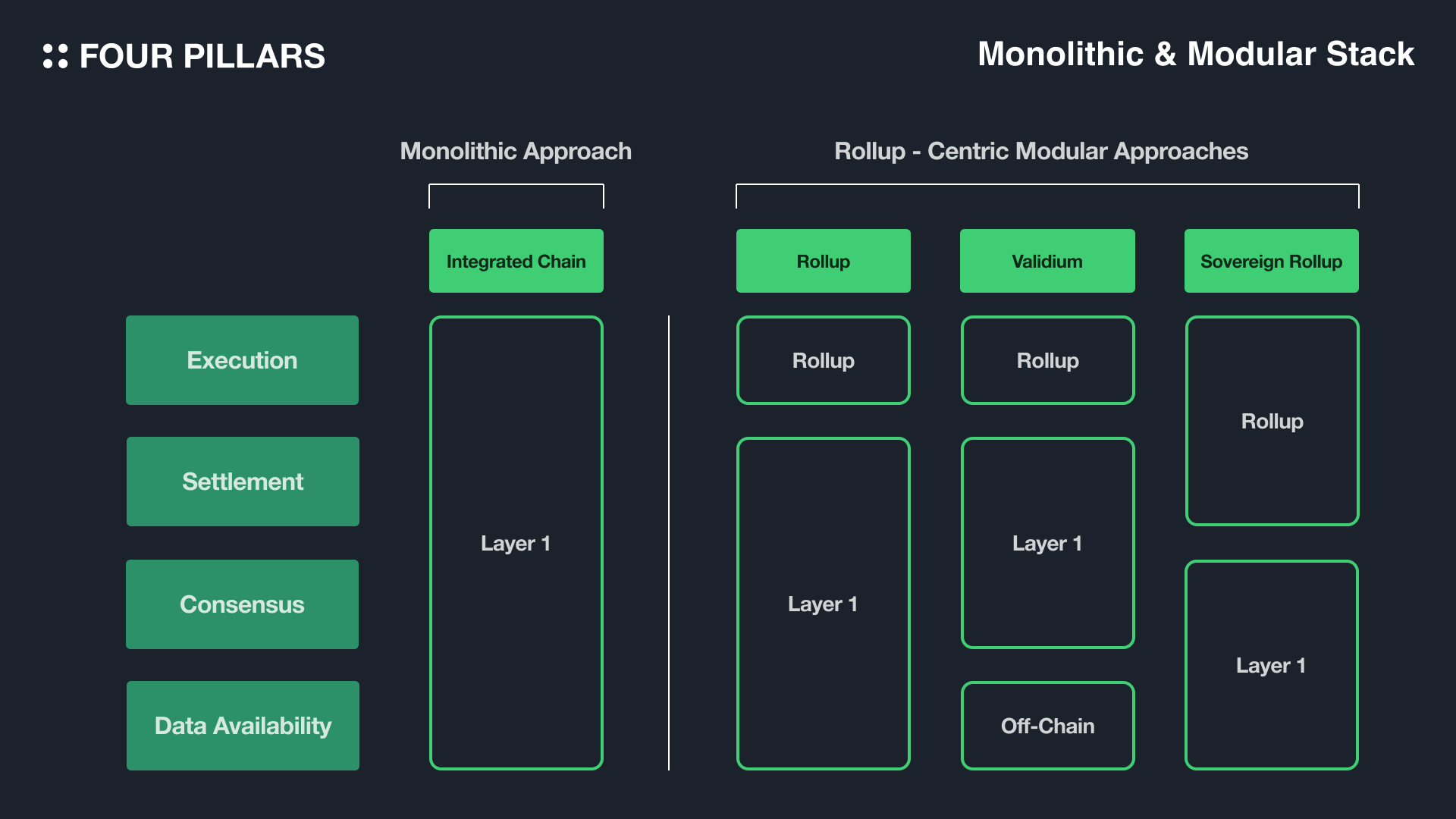
As Ethereum shifts its roadmap towards a rollup-centric approach, the concept of modular blockchains has risen sharply, with related projects starting to dominate market share. The essence of modular blockchains is to distribute the roles of consensus, execution, settlement, and data availability to different protocols, thereby overcoming the limitations of integrated blockchains through improved scalability and flexible governance.
However, the complexity is a critical drawback in modular blockchain structures. Considering the journey of a single transaction processed through various protocols, this complexity entails 1) constant checks for compatibility and dependencies, 2) increased communication costs, and 3) difficulties in swiftly identifying and resolving unpredicted issues. How can such a system be confidently stable? For infrastructure to be stable and sustainable, it must fundamentally be simple.
Solana exemplifies this principle by leading the integrated blockchain faction with a focus on simplicity and composability. Since its launch, Solana has built a distinctive technology stack prioritizing these values, attracting unique applications that differentiate it from the Ethereum ecosystem and fostering a growing community.
This showcases the effectiveness and significance of the integrated-blockchain approach in the industry, challenging the idealistic and academic atmosphere prevalent, especially in the Ethereum-focused sector in terms of real use cases. Also, this has undoubtedly influenced the emergence of various integrated blockchains (e.g., Sui, Aptos, Sei, and etc.) today and will continue to do so.
The simplicity and composability Solana advocates for aim not just at superficial performance improvements through expensive hardware but at designing a network that ensures efficient functions close to that of a single node by optimizing and simplifying software and communication technologies.
This emphasis on creating a developer-friendly environment is crucial. Developers can eliminate all complexities related to stack selection for application building and ensure compatibility between various smart contracts, optimizing their resources. Low latency, cheap fees, and the benefits of parallel processing, leading to a localized fee market, remove communication inefficiencies potentially caused by bottlenecks in single applications.
Furthermore, Solana offers a range of built-in features within its simple technical stack, such as configurable token standard libraries, cross-chain interoperability, and RPCs for token balance queries without relying on external indexers, fostering organic interactions between applications.
With comprehensive technical, financial, and operational support programs for developers, Solana provides an ideal environment for product-minded developers, strengthening an ecosystem aligned with Solana's values.
Blockchain technology is inherently inconvenient, yet its unique value to the real world justifies the involvement and building within this ecosystem. However, this value becomes meaningless without adoption. Solana understands this better than any other mainnet, possibly aiming to develop towards practicality rather than being overly swayed by the original values blockchain aimed to pursue. Solana's vision for its blockchain ecosystem is ‘Real Adoption’.
Solana currently focuses on three main areas: DePIN, Mobile, and Payment – sectors closely related to our everyday life infrastructure. DePIN utilizes blockchain's decentralization to maintain and operate real-world infrastructure networks, with narratives forming rapidly around Solana. The low fees and fast processing of Solana are particularly well-suited for the capital-intensive real-world infrastructure sectors, such as computation and storage assistance, telecommunications, mapping, and data centers. The development of DePIN and Payment will significantly contribute to forming real-world infrastructure using Web3 features, and conversely, serve as a major onboarding method for off-chain users to bring their activities and assets into Solana's on-chain environment. These off-chain users can naturally accumulate on-chain experiences through devices like the Saga mobile and utilize various on-chain asset classes, including RWA.
In summary, Solana's ecosystem not only blurs the boundaries between off-chain and on-chain spaces but also enhances the significance of each domain.

The crypto industry has seen rapid growth in a relatively short period, attracting significant attention. The volatility experienced during this growth has become a familiar phenomenon among industry participants. However, the level of volatility Solana faced was exceptional in particular - during the peak of the blockchain boom in 2021-2022, supported by FTX, the world's second-largest crypto exchange, and its head, Sam Bankman-Fried (SBF), Solana rapidly grew into the fourth-largest ecosystem by market capitalization, excluding stablecoins. However, the collapse of FTX dealt a significant blow to the Solana ecosystem, causing the price of SOL tokens to fall by 97% from their peak.
Despite such a severe crisis, Solana is regaining its influence. With active participation from developers and companies, the ecosystem has become much stronger than before. This series of drama was made possible due to Solana's unwavering vision and fast execution.

Source: Solana Whitepaper
“Single Shard Global Synchronized State Machine with Consensus at the Speed of Light”
Solana's journey began in late 2017. Drawing from his experience at Qualcomm, Anatoly Yakovenko researched blockchain technology and identified a major problem in existing solutions: the absence of a trustless universal clock that all validators could use for transaction timestamps.
As such, Anatoly proposed a new method to encode the passage of time using SHA-256 looping and synchronize clocks across multiple nodes through this data structure. In contrast to traditional blockchains, which require extensive communication between nodes to agree on and order transaction times, having a globally verifiable clock allows for the network to be synchronized more simply and transactions to be processed almost immediately upon arrival.
This idea materialized as Proof of History (PoH), aligning with Solana's hypothesis that if software does not hinder hardware, the entire network performance can linearly increase with hardware advancements. Today, Solana is capable of processing thousands of transactions per second, with block times recorded at 400-500ms—significantly higher performance than existing blockchains.
Ultimately, Solana's adoption of this technical approach aims to achieve two missions: an expandable platform that can handle high usage and composability between applications. Through an integrated blockchain design that shares a globally synchronized single state, developers can more easily write programs (i.e., smart contracts), thus simplifying application development and improving end-user experience.
Solana's development philosophy, use of multi-threading for parallel processing, and consistently proven excellent network performance played a crucial role in forming a community centered around pragmatic developers. The peak of the blockchain narrative atmosphere at the time, along with the demand for fast transactions and low fees spurred by the DeFi and NFT boom, positioned Solana as a genuine mainnet competitor to Ethereum.
However, the collapse of FTX caused a temporary halt to this scenario. At the time, Solana was closely linked to SBF, who publicly supported the Solana ecosystem and onboarded projects like the DEX project Serum and various projects that would typically be found in the Ethereum ecosystem to Solana. FTX, under SBF's support, grew into the world's second-largest centralized exchange, thereby increasing his influence within Solana. However, FTX's misuse of company assets and customer deposits for loans and investments in its hedge fund, Alameda Research, led to its downfall. This, in turn, put the Solana ecosystem, which heavily relied on FTX, at risk of collapse.
Though Solana's ecosystem seemed to crumble, builders who resonated with Solana's philosophy remained. The first action Solana took in this situation was to enhance the network's stability and developer-friendly environment by addressing technical aspects, and restoring trust from the community.
3.2.1 Technical Side
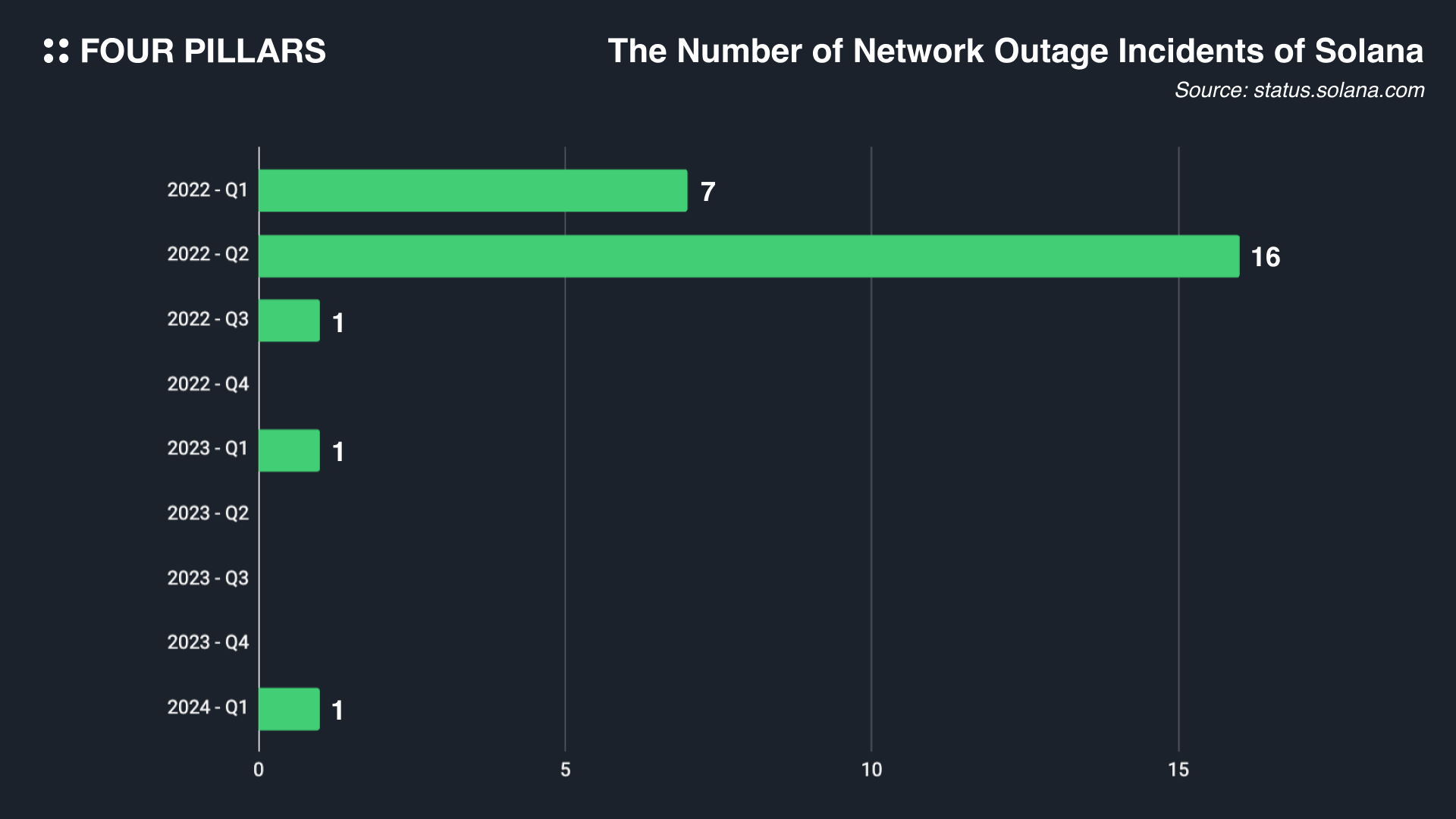
The structure of the Solana network was vulnerable to spamming, leading to frequent network outages. This issue primarily stemmed from the network's design intentions to maximize communication speed, such as a cheap fixed fee system and a predetermined leader node system. To address these issues, Solana took measures to improve by introducing QUIC (Quick UDP Internet Connections), Staked-Weighted (Quality of Service), and a Localized Fee Market, among others.
QUIC
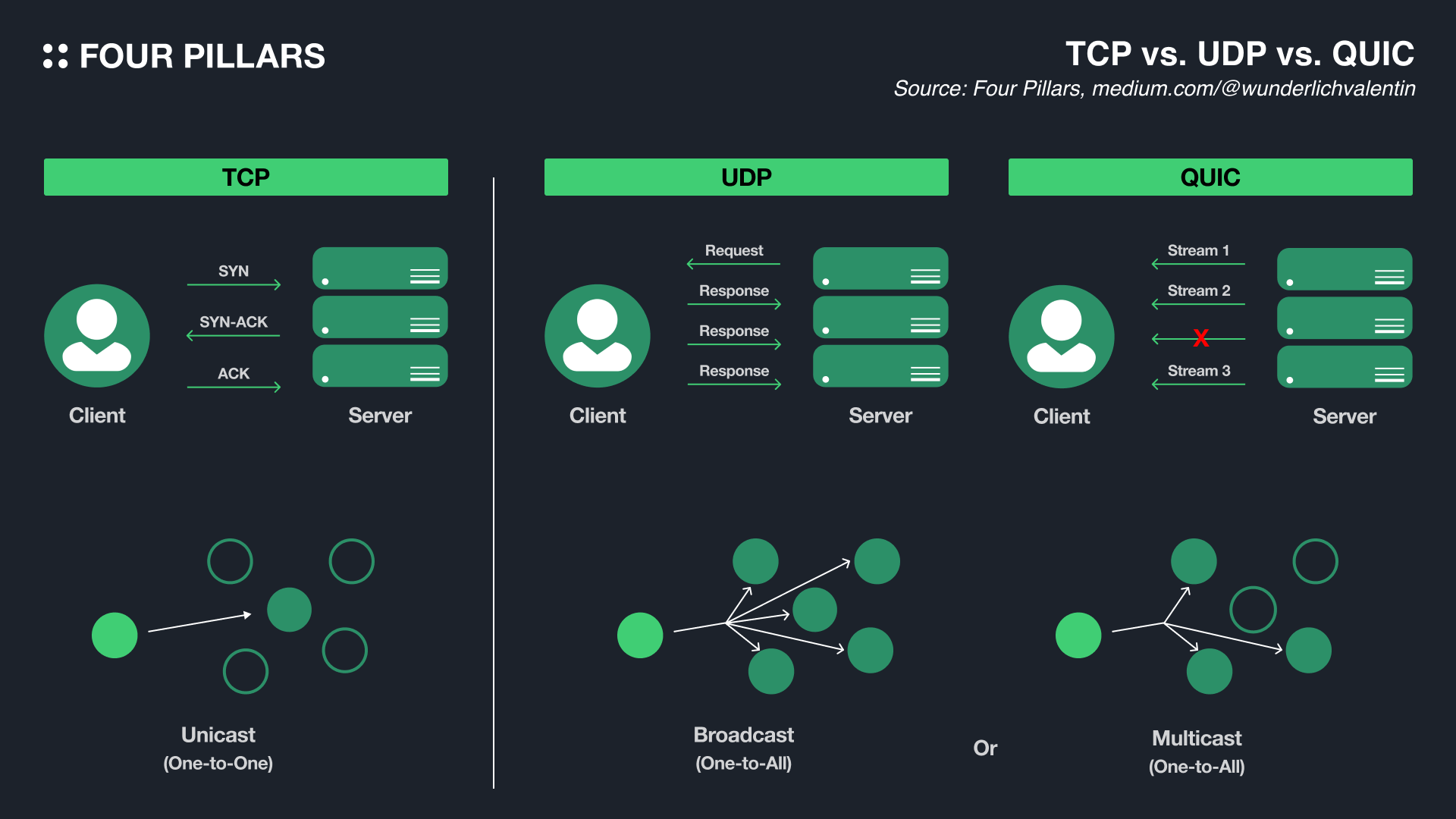
The Solana network used a custom UDP protocol for communication between RPCs and leader nodes. This approach simplified the communication process and accelerated transmission speed but lacked reliability and control elements necessary to prevent spamming due to the inability to confirm packet delivery (i.e., Acknowledgement) and identify the source IP. UDP's characteristics, suitable for services where continuity like real-time streaming is crucial, were deemed unsuitable for the blockchain environment, which demands security and stability.
To overcome these problems, Solana decided to adopt the QUIC protocol developed by Google. QUIC is a new communication protocol based on UDP, maintaining its advantages while simplifying TCP's connection streams and handshake processes. Thus, QUIC allows Solana to achieve reliable communication, request retransmission only for streams with packet loss, and continue transmitting the rest without interruption, significantly enhancing network efficiency.
Staked-Weighted QoS
QoS prioritizes certain types of traffic when more traffic is requested than the network can handle. With the introduction of QUIC, discussions on its use emerged—Solana's leader nodes, previously using UDP, processed transactions based on their arrival without considering their origin. However, with QUIC, Solana’s leader nodes can now identify the IP requesting the transaction, allowing them to specify and limit the traffic priority for certain connections.
The degree of traffic limitation is proportional to the amount of SOL staked, the essence of the Staked-Weighted QoS policy. That is, the maximum packets a validator node can transmit are proportional to the amount of SOL tokens staked on the Solana network, increasing the likelihood that transactions exceeding an individual node's transaction cap are dropped by the leader. This method aims to 1) block malicious validator nodes causing spam attacks and 2) encourage validators with high transaction demand to stake more SOL tokens, enhancing Solana's security and demand for SOL tokens.
Localized Fee Market
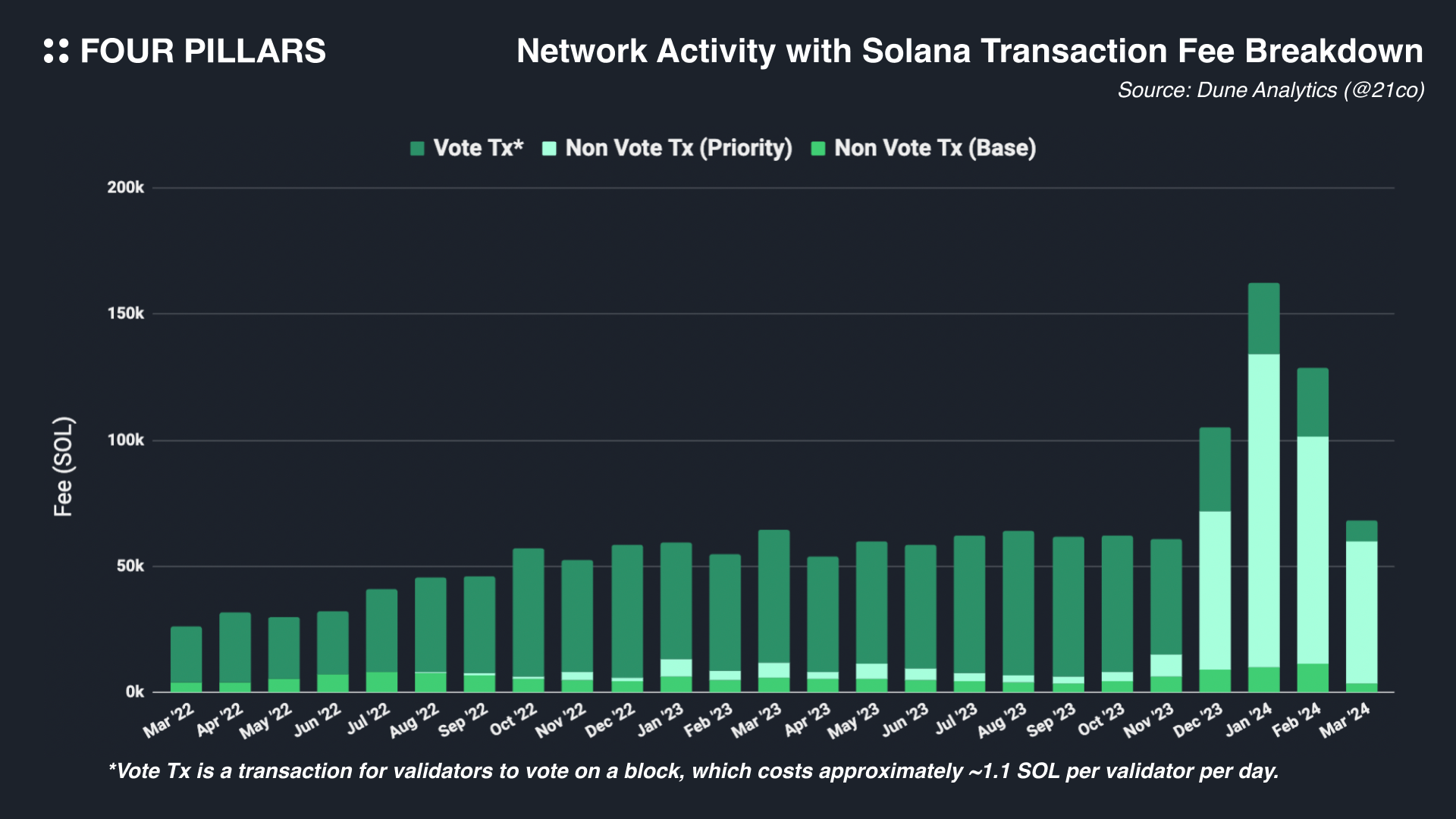
While Solana applied a fixed gas fee policy, maintaining a constant fee advantage, intense block space competition could lead to transaction failures or induce network spamming by users trying to ensure their transactions succeed. To solve this, discussions on introducing a fee market system in the Solana ecosystem began. This system allows users to add a premium to their fees to ensure their transactions are processed quickly, thereby deterring spam activities and enhancing network efficiency.
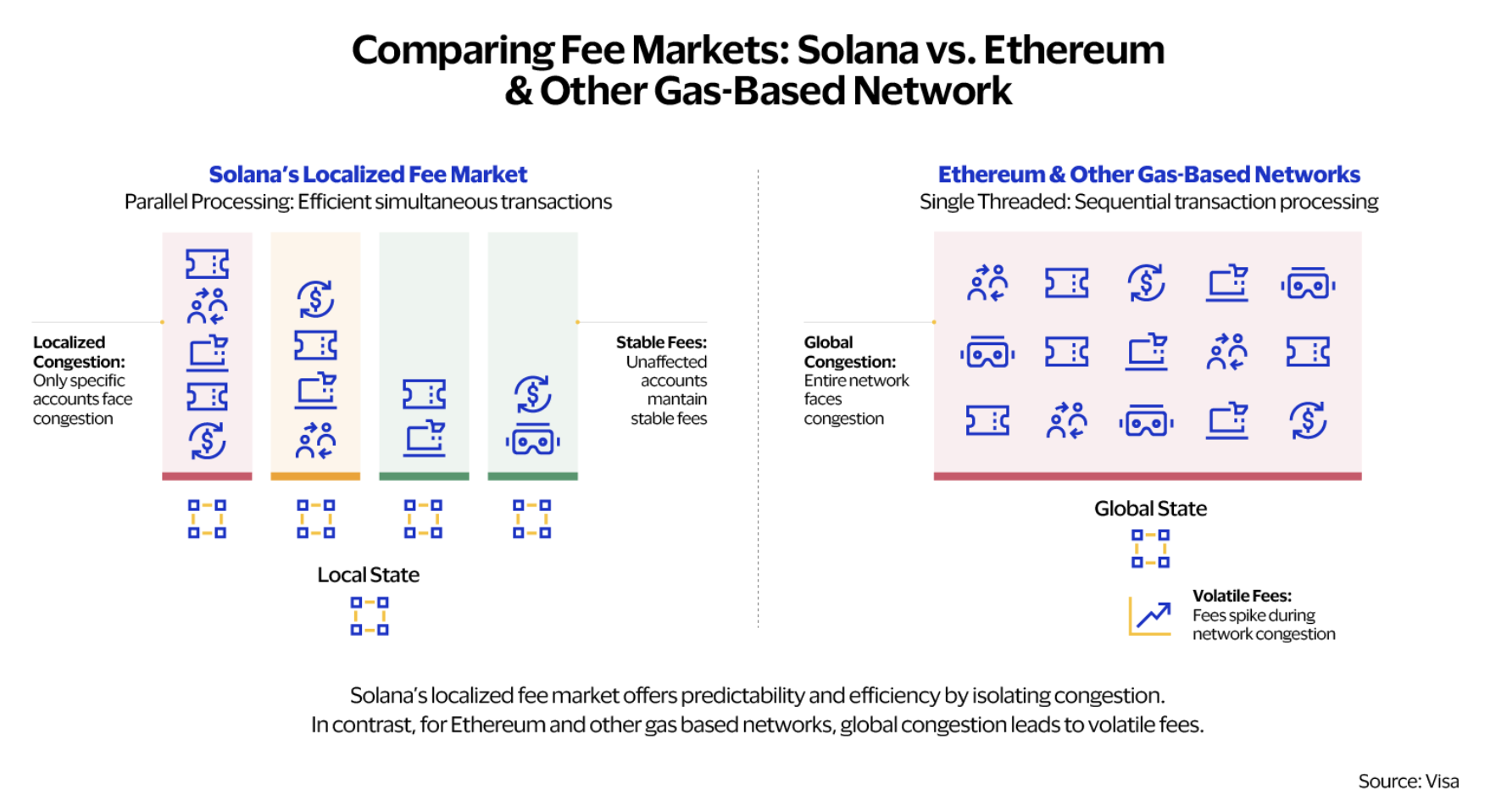
Source: Visa
Taking it a step further, Solana adopted a Localized Fee Market approach, limiting it to specific applications or markets to minimize the overall network impact when demand for certain actions increases block space competition. This logic is possible because each Solana transaction specifies the state parts to be modified for a particular account in advance, and transactions can be processed in parallel. For example, even if the gas fee for minting a specific NFT skyrockets due to high demand, it doesn't affect the fee market for other accounts unrelated to minting, such as token transfers. Currently, the Localized Fee Market applies to specific applications, markets, and AMM pools, limiting the maximum computing units (CU) an individual program can use per block to 25% in 'hotspots' where fee competition due to excessive transactions is fierce.
Discussions continue to refine the Localized Fee Market, including fee structure, with the fee policy as of writing being as follows.
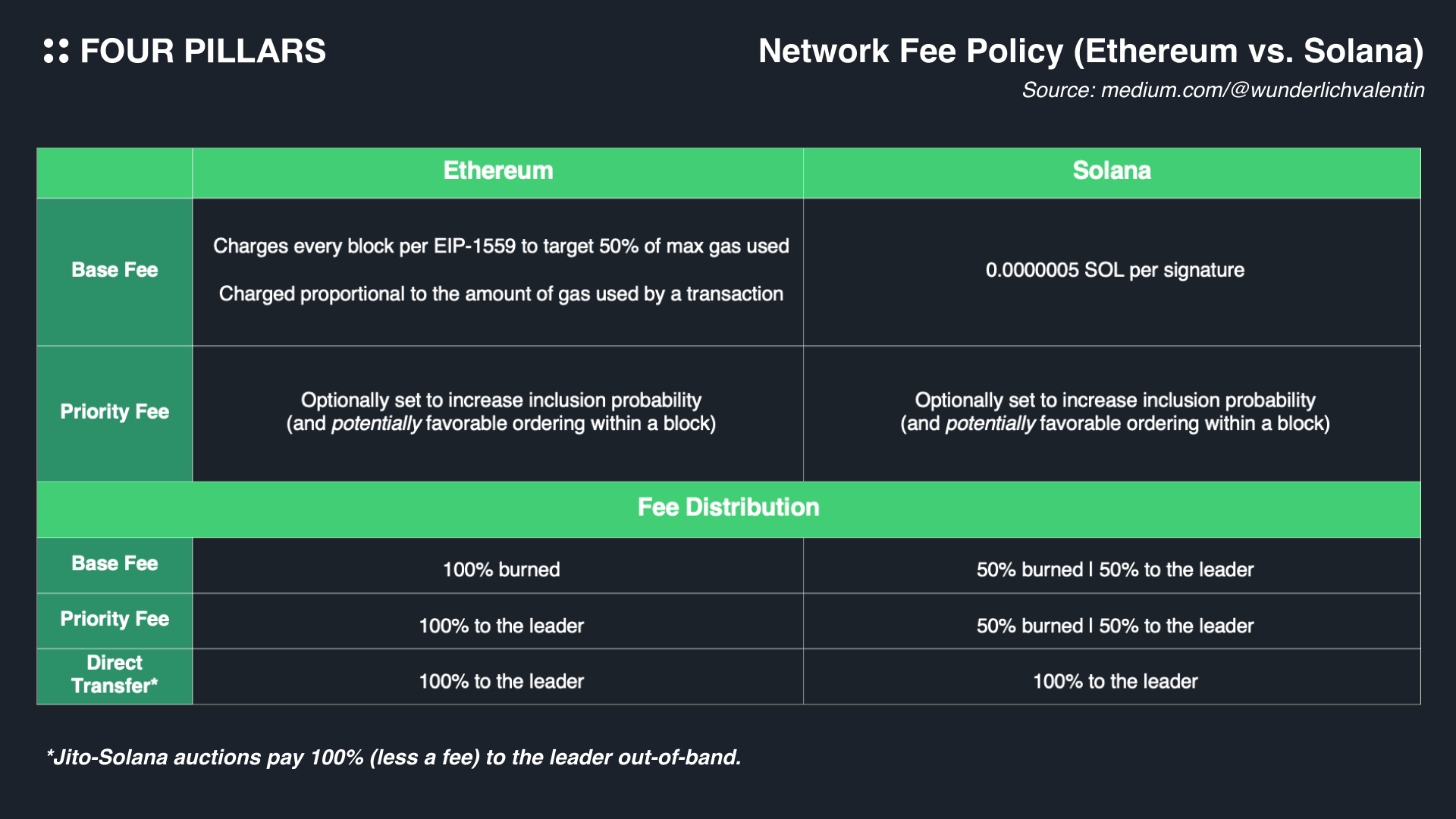
In addition to this, SIMD-003 discusses introducing a dynamic base fee to further prevent spam problems, and SIMD-0096 suggests paying leaders the entire amount of priority fees, including the 50% that is supposed to be burned.
3.2.2 Ecosystem & Operation Side
Beyond those technical efforts, Solana's ability to draw interest from the market and regain trust is attributed to actively approaching areas where its technology stack can be well leveraged, and fostering a developer-centric community.
Strengthening Community Sentiment
The Solana community, through various platforms such as the foundation, hackathons, and Superteam Earn, actively provides the necessary resources and support for developers passionate about contributing to the ecosystem. It operates on the principle that ‘benefiting developers is crucial for sustainable ecosystem development’.
As part of this, a meme coin called BONK, created by the LamportDAO community, airdropped 5 percent of its total allocation for developers remaining in the Solana ecosystem wishing for the reconstruction of the Solana ecosystem. This meme token helped unify the community, and as developers rebuilt the ecosystem, the meme token gained traction, marking a record price increase of 15,680% above its lowest price at a certain point. The rise in BONK token's price induced a virtuous cycle of rejuvenating interest in Solana and its ecosystem, eventually leading to a proposal for a 30 million BONK token airdrop to Saga mobile device users, heightening market interest in BONK and the Solana ecosystem further.
Recursively, protocols such as Jito (MEV solution client & staking platform), Pyth Network (oracle network), and Jupiter (DEX) also announced strategies for airdrops, stimulating market interest in Solana. Other protocols within the ecosystem, including Tensor, marginfi, Zeta, Parcl, announced point policies, contributing to the vitality by gathering expectations for airdrops among participants in the Solana ecosystem.
These cases are significant examples of how a culture respecting the community combined with superior product design can breathe new life into an ecosystem.
Approaches for Web2 Infra
As the fervor for blockchain during its peak in 2021-22 began to wane, a major question left by the market was, "Why use blockchain?" Consequently, each mainnet began to solidify their identities further and discuss measures for real adoption. With this context, another factor that attracted significant interest to Solana from the market was its quick execution of various initiatives that practically bridge the real-world infrastructure with the on-chain world, beyond just pondering these questions.
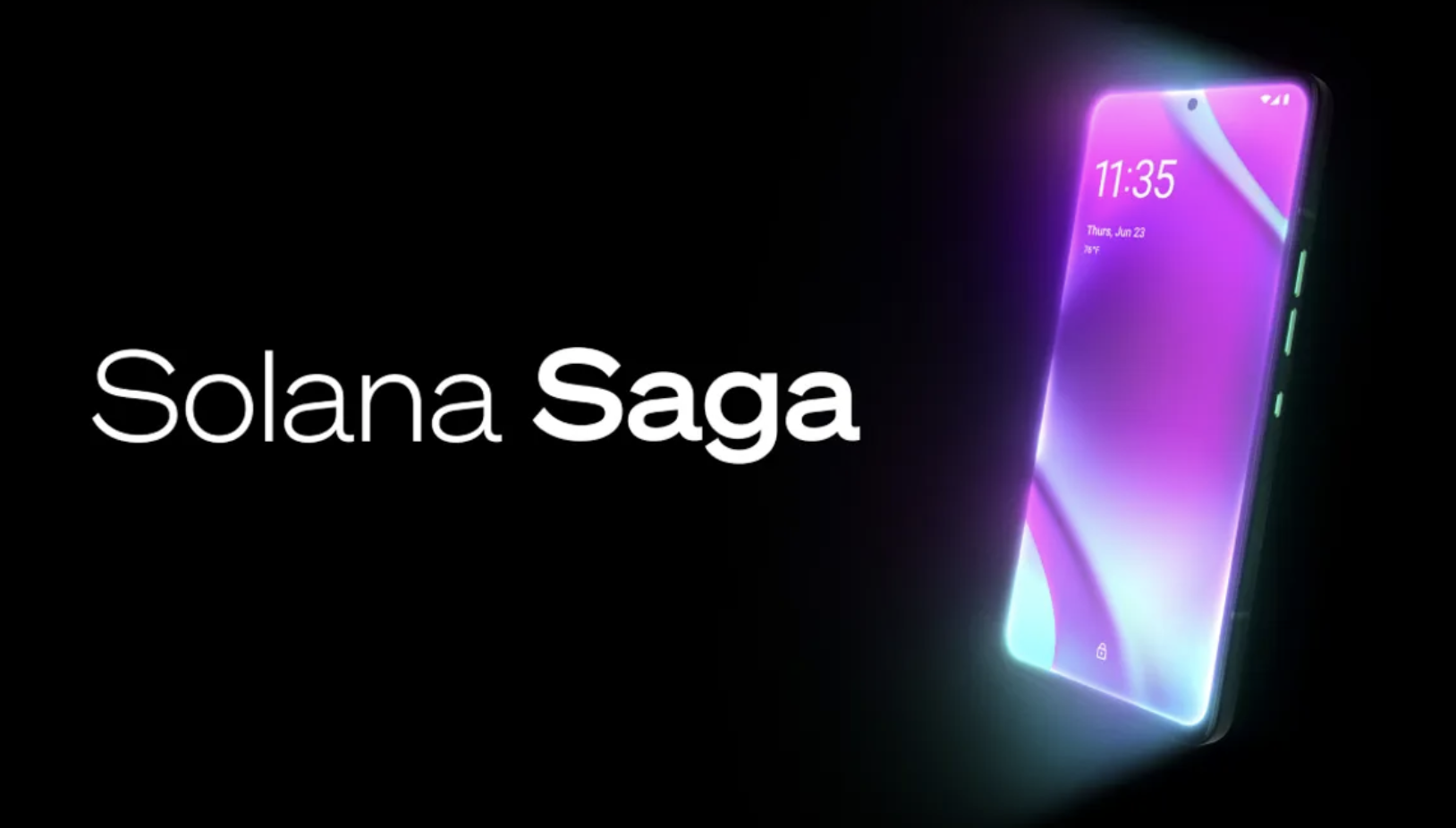
Source: Solana
Prominent among these initiatives are DePIN and Mobile. As explained in the introduction, DePIN utilizes blockchain technology's decentralization characteristic to maintain and operate real infrastructures. Solana is uniquely pioneering the DePIN area, creating its narrative. This aims not only to present use cases that can replace/complement real-world infrastructure with the grammar of Web3 but also to construct a funnel that draws off-chain users into the world of Web3, allowing them to pipeline Web3 experiences. The physical environment equipped with an app store and various features to offer an aggregated experience of the Solana ecosystem to these users is the Saga series of mobile devices launched by Solana - the first Saga series released in 2022 saw initial low sales but sold out by December as BONK token news and the vitality of the Solana ecosystem spread, and pre-orders for the second series launching in the first half of 2025 surpassed 100,000 as of February 13th.

The second area is Payment. Indeed, P2P-based blockchain crypto asset payments have been frequently mentioned as a use case that can meaningfully solve issues like intermediary problems, high fees, and slow transaction times of traditional financial systems. Solana is positioning itself as the most suitable blockchain for crypto asset payments with its multi-threading for parallel processing, fast processing speed, and low transaction costs. It is actively strengthening initiatives in this area to make blockchain transactions as intuitive and straightforward as credit card payments - Circle's USDC has long announced an official partnership with Solana, and the open-source Solana Pay announced in February 2022 enables various applications to build crypto asset Payment features. Solana Pay's plugins have been integrated with Shopify, Citcon, Checkout.com, and Visa has announced including Solana in its stablecoin payment infrastructure.
Initiatives for Client Diversity & Validator Decentralization
Moreover, based on the principle that diversity in validator clients enhances network stability and security, Solana is working to improve resilience through initiatives for various validator clients - diversity in clients can minimize the impact of a single software flaw on the entire network since a bug or vulnerability present in one client may not be found in another.
Initially starting as a single client from Solana Labs, Solana began to achieve client diversity with the release of a second client, Jito-Solana, developed by Jito Labs in August 2022, and reached testing versions of an independent validation client based on C/C++ developed by Jump Crypto, called Firedancer.
Additionally, Tinydancer, a diet client enabling transaction validation at low cost, has also received considerable interest, particularly as it mitigates misunderstandings that decentralization is not genuinely happening due to the high hardware specs* typically required to run a Solana node - optimizing hardware specs to enhance the performance of the Solana network is essential, but as per Vitalik's Endgame post, reducing node operation specs to enable more people to produce blocks is not beneficial for the network's scalability, quality, and stability**.
*Recommended specs for operating a Solana node are as follows:
12-core CPU with a minimum clock speed of 2.8GHz
128/256GB of RAM (RPC nodes might require more for custom database indices)
2-4 NVME drives of at least 1TB
10 Gbps Network
**The proposal of PBS (Proposer — Builder Separation) structure by Ethereum is also based in this context.
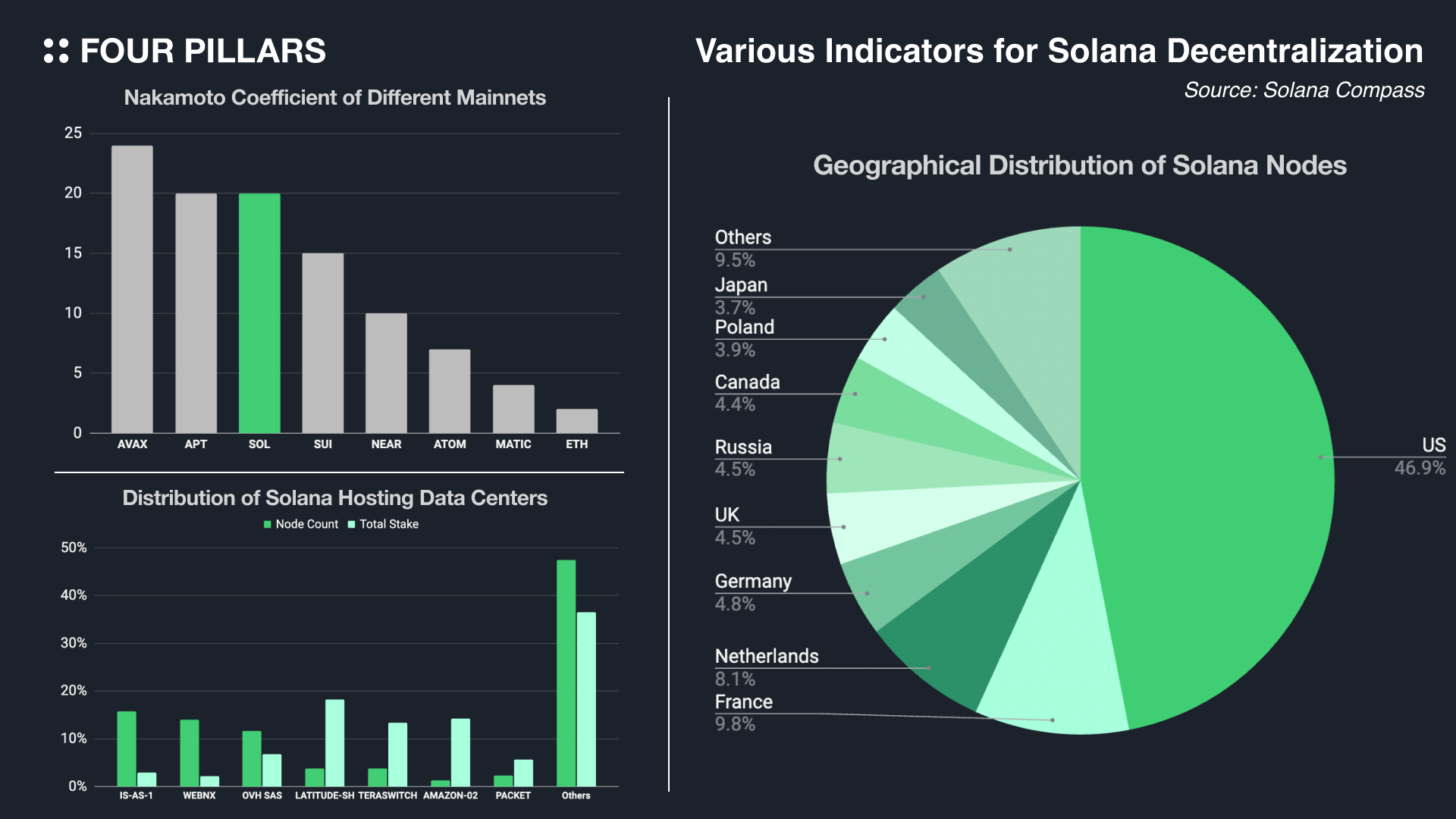
Despite requiring high-spec hardware, the data centers hosting approximately 2,900 Solana nodes are very distributed, and the Nakamoto Coefficient, referring to the number of validators that can cause operational problems for the chain, remains around 20. Though geographically centralized around the US, continuous optimization between software and hardware following Moore's Law and operation of delegation program based on decentralization-related criteria evidence that Solana is gradually achieving decentralization.
In summary, positioned as one of the few chains with several independent validator clients aside from Ethereum, Solana continues its efforts toward decentralization and seeks ongoing stability in the network.
Solana has been solidifying its internal foundation and actively expanding its business outreach. This process has provided enough elements to appeal to institutional investors, with Cathie Wood, CEO of Ark Invest, publicly expressing a positive outlook on Solana's vision, and Grayscale's Solana trust product skyrocketing by 869%. In essence, Solana has proven its potential to recover an ecosystem that seemed to be in crisis with a consistent vision and rapid execution.
In this section, we delve into the elements of Solana's technical stack that have steadfastly supported its unwavering vision and propelled the resurgence of its ecosystem.
4.1.1 Languages

Source: Solana
Solana aims to reduce fees and block times on the surface while technically optimizing software for hardware. This mission necessitated careful selection of programming languages for programs (i.e., smart contracts), leading to the adoption of Rust - known for its concurrency, memory safety, low-level control, and a powerful type system that prevents type errors and ensures code is safe and predictable.
However, Solana ultimately aims to create an environment where all LLVM* (Low Level Virtual Machine) compatible languages can be used interchangeably. Therefore, while Solana's programming language of choice is fundamentally Rust, LLVM allows code written in other languages like C or C++ to be translated into machine code executable on Solana.
For client-side communication with the Solana network, developers can utilize various SDKs built on JSON RPC API in languages like Java, C#, Python, Go, or Kotlin.
*LLVM is a collection of modular compiler and toolchain technologies that enable high-performance, high-quality code to be efficiently optimized across various hardware platforms, making it a preferred development environment for skilled developers.
4.1.2 Core Innovations
Solana applies eight core technologies to ensure top speed throughout the entire process from when a user submits a transaction to when a block is produced. To aid understanding them, let's briefly overview how Solana's consensus mechanism works.
Leader Node Selection - The selection of the leader is based on the staked weight of nodes delegated by token holders, with validators rotating according to a Leader Rotation Schedule*.
Timestamping Transactions - The leader node receives transactions and timestamps using PoH.
Block Creation - The leader starts creating a block with its PoH Sequence.
Block Propagation - The newly created block is sent to replicator nodes (i.e., other validators in the network).
Transaction Validation** - Replicator nodes verify the transaction order using their PoH Sequence and ensure the transactions comply with network rules. Since transaction order relies on their PoH Sequence (i.e., global clock), no P2P communication between nodes is needed.
Block Finalization - Once transactions are ordered and validated, the block is added to the blockchain. Then, the next leader is selected, and the process starts over.
*Solana is so fast that it has a Leader Rotation Schedule so that the leader is known one epoch in advance to ensure that blocks are not delayed or stale.
**This will be further clarified below in the Proof of History section.
Proof of History
As briefly touched upon in the introduction, the essence of PoH is that validators independently generate a global clock reference for all transactions order. For example, hashing a previous hash (i.e., hash1) to produce hash2 (i.e., sha256(hash1)) intuitively indicates that hash1 preceded hash2. Solana calls this process a ‘Sequence.’

Source: Solana Whitepaper
This sequential hashing data structure serves as proof of the passage of time, allowing validators to rotate the lead verifier without needing to share elapsed time with others. This is why Solana, with PoH, can have shorter block times than other blockchains.

Source: Solana Whitepaper
Generating this sequence is possible only through single-core processing due to the need to reference the previous output hash, but the verification can be done through multi-core as its logic is simple - hash computation. Thus, it achieves Solana's philosophy of "linearly scalable verification per node to hardware."
Therefore, PoH is more akin to a global clock data structure or a Verifiable Delay Function (VDF) implemented with a sequential hash function than a consensus algorithm, where Solana actually uses Tower BFT DPoS for consensus algorithm.
Tower BFT DPoS
Tower BFT can be described as a version of PBFT optimized with PoH. Tower BFT utilizes Solana's PoH as a global clock to pre-determine order, focusing solely on the consensus process, significantly reducing messaging overhead and latency. The process of validators reaching consensus through Tower BFT is as follows.
Validators vote on the version of the ledger they believe to be accurate, discarding any they deem incorrect, without the need for P2P communication, during a fixed slot duration (i.e., ~400ms)*. With each vote on subsequent slots after a certain point, the timeout required to rollback to a previous block doubles. This means that as the PoH Sequence that the majority of validators have voted for continues, it becomes increasingly difficult to rollback - for example, if all validators voted 35 times over the past 14 seconds (14,000ms / 400ms = ~35 slots), the effective time limit of the network would be ~435 years(2^35*0.4/3600/24/365), making a rollback practically impossible.
As a result, only ‘the heaviest Sequence,’ which is the hardest to rollback because the majority of validators voted for it, remains in the blockchain, and those validators who voted on this Sequence receive rewards. In short, thanks to PoH, validators with Tower BFT can asynchronously calculate timeouts without the need for P2P communication, ensuring that votes are timely, maintaining network liveness and reducing the likelihood of forks.
*Voting is weighted based on the stake each validator holds in the network.
Gulf Stream
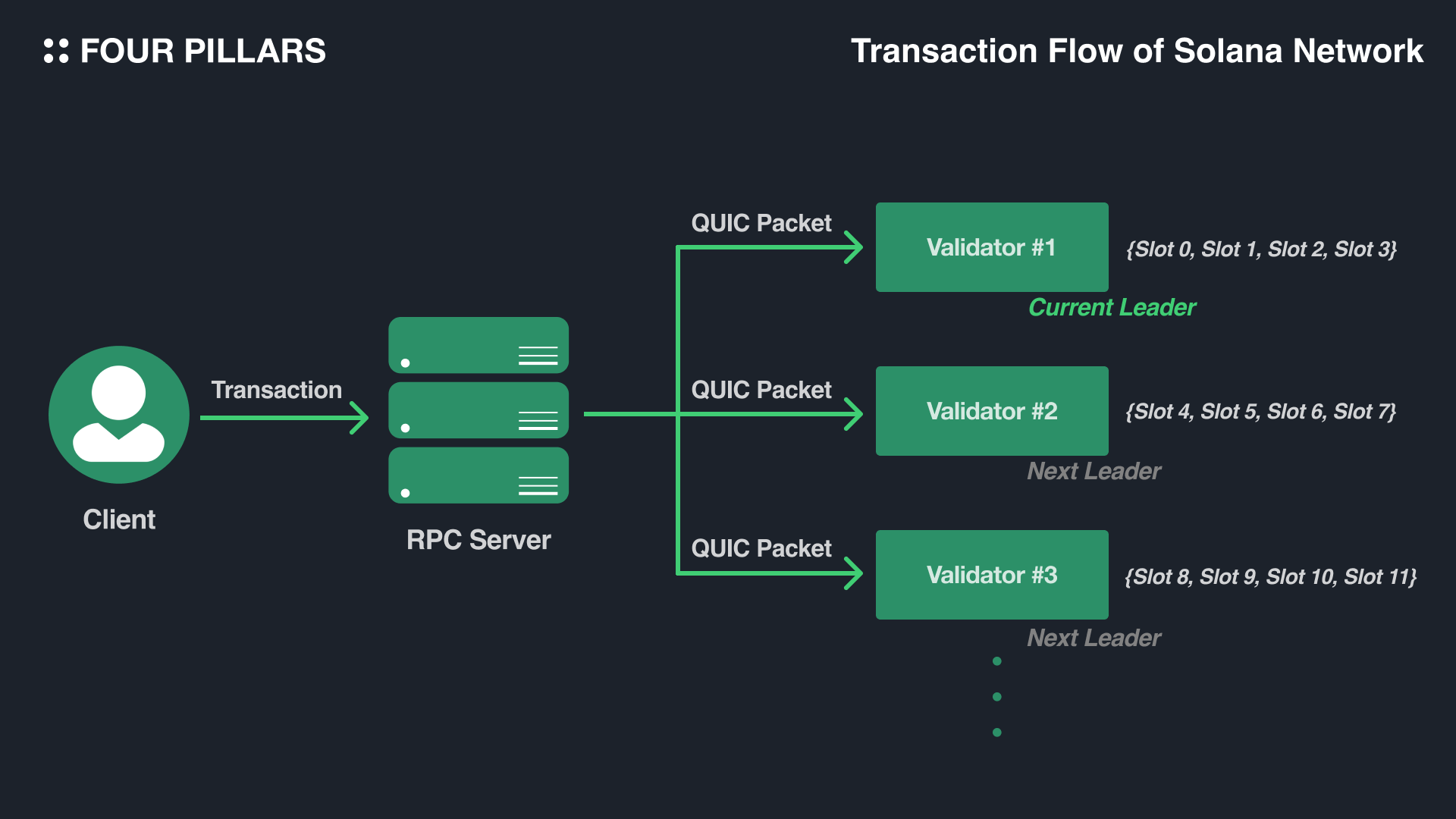
Unlike other blockchains, Solana does not require a public mempool to hold users' transactions because block space is not scarce relatively due to high transaction throughput. Instead, when users submit transactions, RPC servers convert them into QUIC* packets, immediately forwarding them to validators slated to be the next leaders. This approach, known as Gulf Stream, allows for quick leader transitions and pre-execution of transactions, reducing memory load on other validators.
*Initially UDP, updated to QUIC mid-2022 as previously mentioned.
Sealevel & Cloudbreak
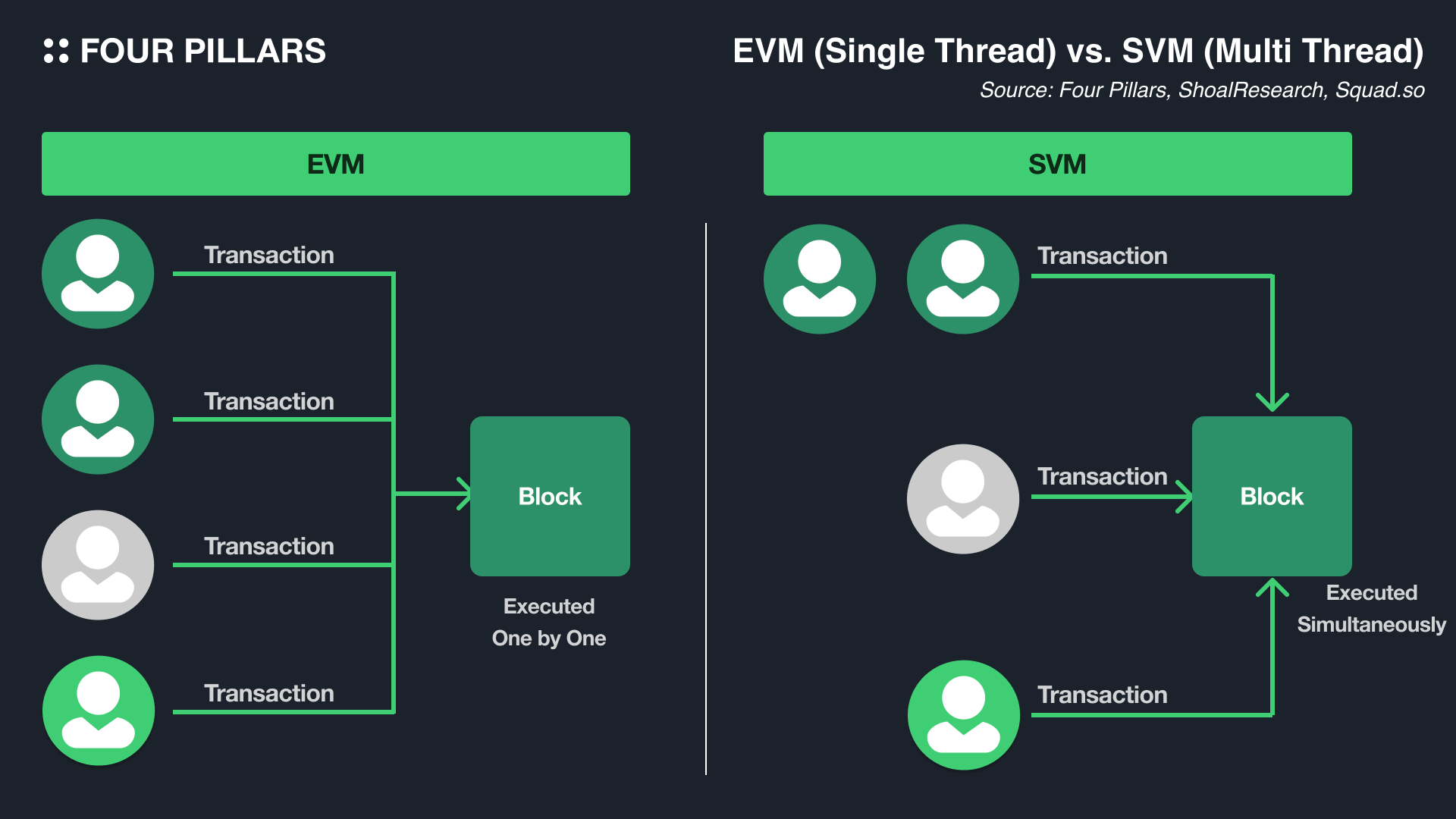
Sealevel is a core technology that enables multi-threaded parallel processing in Solana, unlike EVM or WASM-based runtimes*. It relies on 'Instructions' within each transaction, with the accounts array containing global state information of the Solana network. Transactions are pre-classified based on declared read/write states per account for parallel processing.
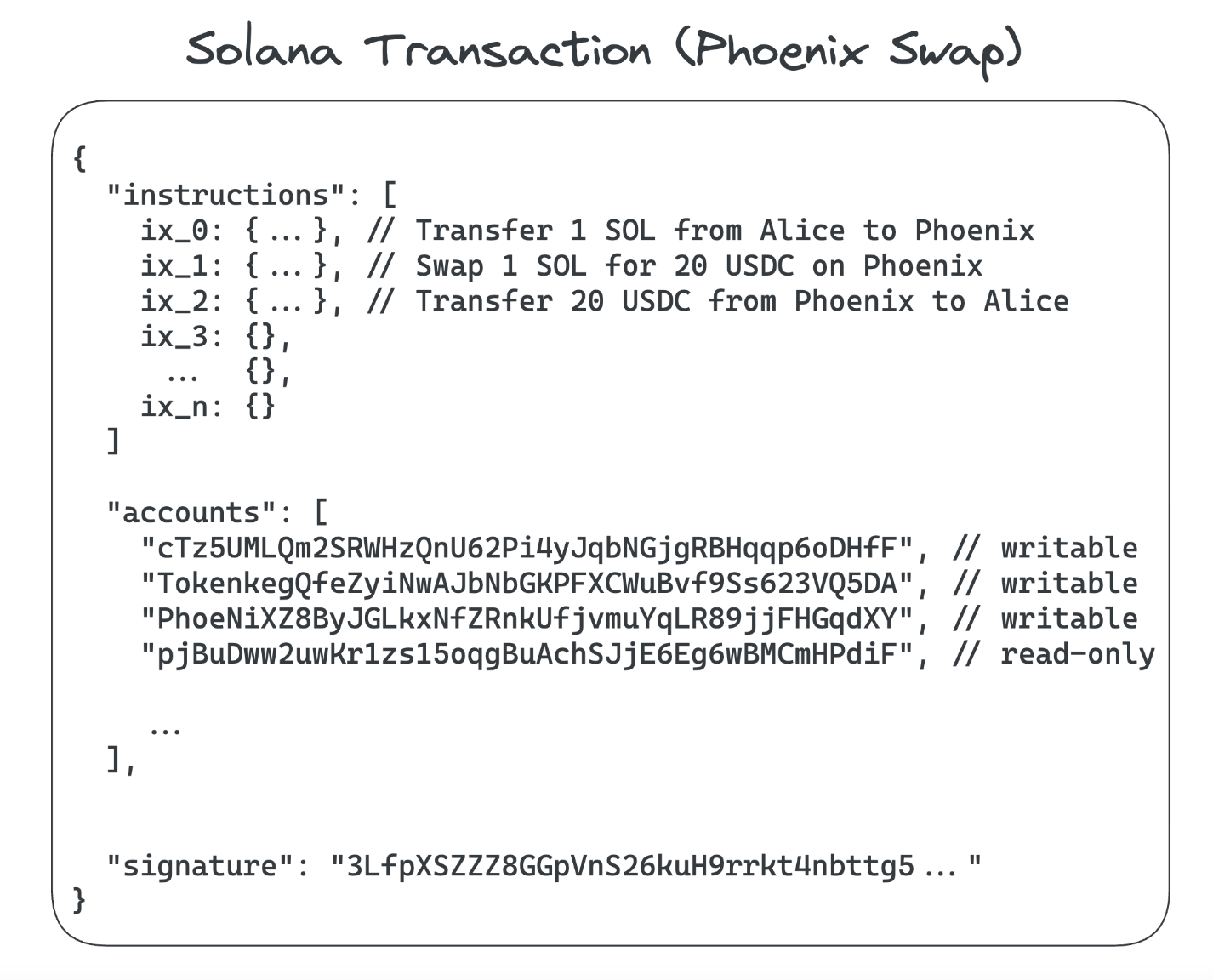
Source: Lifecycle of a Solana Transaction
By the way, it is very difficult to organize the account database in such a way that it can be read/written simultaneously by multiple threads, even with any traditional database. To this end, Solana developed Cloudbreak to maximize the efficient use of SSDs by partitioning the account data structure in a specific way to benefit from the speed of sequential operations and adopting memory-mapped files.
*As mentioned earlier, this parallel processing logic in Sealevel is also the reason why the Localized Fee Market implementation was possible.
Pipelining
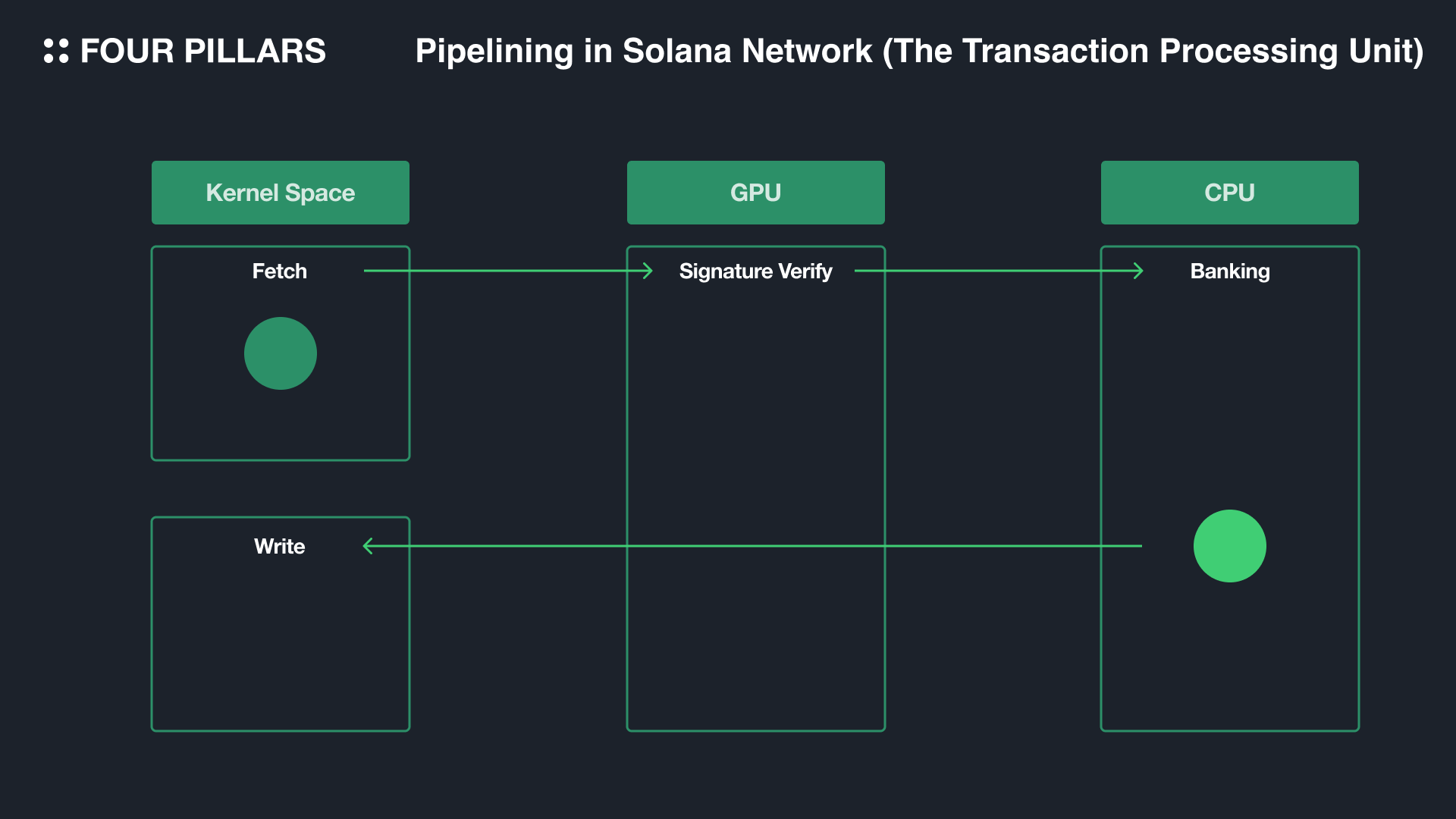
Pipelining in the Solana blockchain is a technique that divides data input streams (i.e., QUIC packets received in advance by the next leader) into multiple processes operating in different parts of the hardware.
The pipelining process goes as follows.
Data is brought into kernel space, where it is then passed to the GPU to allow for parallel signature verification.
Once signatures are verified on the GPU, the data is handed off to the CPU for the banking process.
Simultaneously, kernel space is already preparing the next set of data, while the CPU processes data for recording (writing) on the blockchain before transmitting it to the next block.
Solana maximizes hardware utilization and enhances efficiency through pipelining, speeding up the verification and transmission of blocks.
Turbine
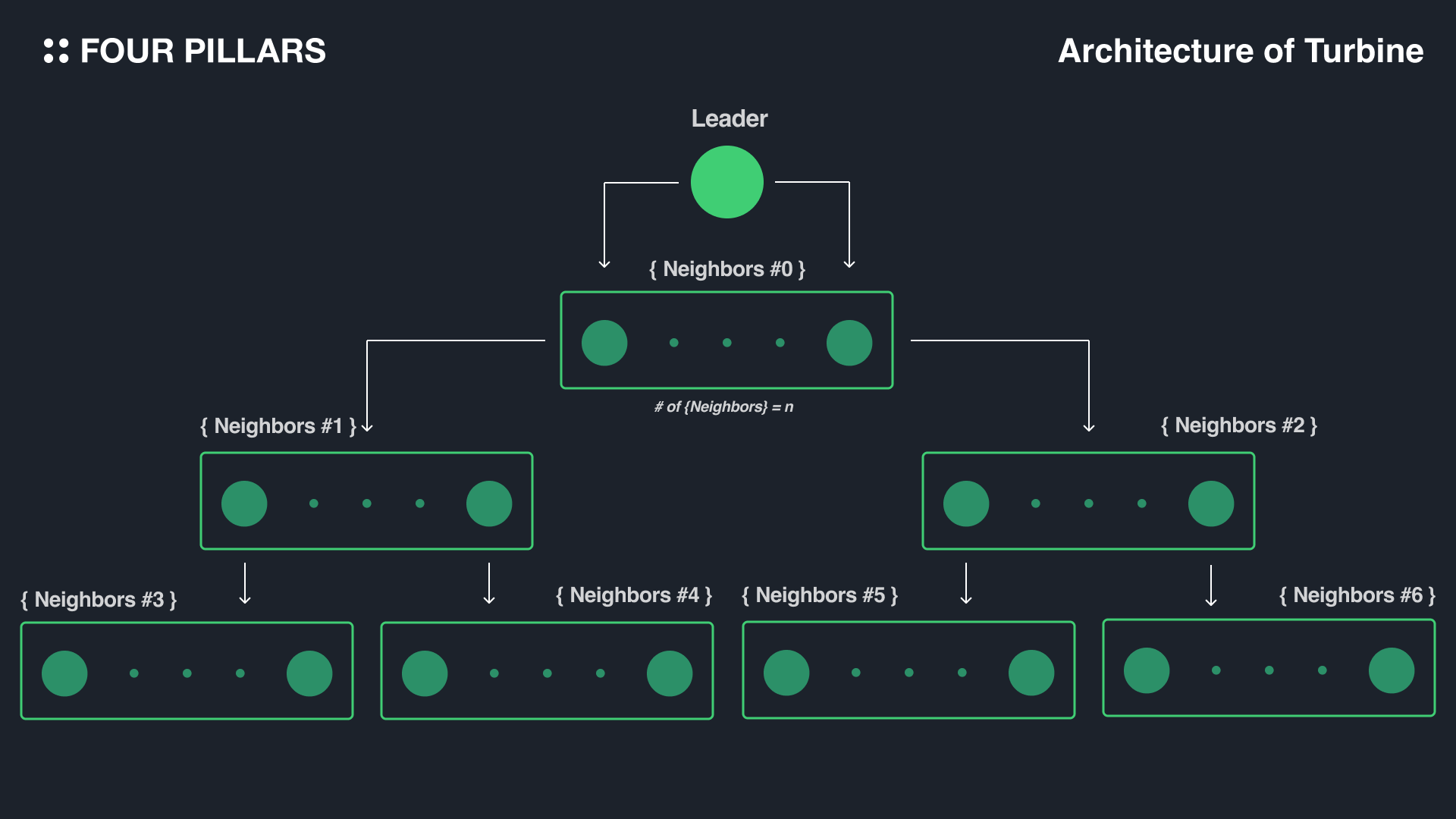
After transactions are processed, the leader must propagate the changed State to each validator. If large volumes of data were to be sent individually to many validators, it would be highly inefficient. To address this issue, Solana employs a technology called Turbine, similar to the one with BitTorrent. Simply put, this technology involves the leader dividing QUIC packets (optionally with erasure codes) into smaller packets and distributing them to validators with a hierarchical structure.
For instance, consider a 128MB block. To process this block, the leader divides it into 2,048 pieces of 64KB packets and distributes them to a few validators. These validators, in turn, retransmit the packet pieces to other colleague validators, referred to as Neighbors - initially receiving validators are chosen among nodes with a high staking ratio of SOL tokens. Validators recursively pass on part of the data they received to the below group of Neighbors. This architecture allows the data initially intended for transmission by the leader to eventually reach a number of validators exponentially proportional to the size of the Neighbor group(i.e., n) as the stages deepen. As the size of the Neighbor group increases, the steps required to connect the network decrease in a logarithmic scale, allowing for rapid data propagation.
Especially in cases where a few validators at higher levels engage in malicious activities (e.g., Eclipse Attack), they could potentially have a relatively large impact on the entire network. Therefore, the network adopts a method of sending packets through different random paths each time.
Archiver (Ledger Replicators)
Solana's Archivers are used to store approximately 4 petabytes of data generated annually by the network. They can be considered a type of light client that does not download the entire Solana ledger but stores only a part of it, allowing a broad spectrum of validators with varying hardware requirements to participate.
When Archivers are allocated data to store from the network, they perform a role of verifying the authenticity of the data through Proof of Replication (PoRep), a technology based on Filecoin. Archivers announce their storage space to the network and receive up to 3% of inflation as a reward for storing and verifying the assigned data.
The key technologies previously discussed enable fast transaction processing, a parallel execution environment, and low latency, making Solana an ideal infrastructure for applications built on its network. However, Solana's high throughput can also pose challenges in securing network stability against MEV bots or spamming. In response, Jito emerged as Solana's second client in August 2022 to address the inefficiencies in MEV extraction and centralized liquid staking protocol issues, contributing to network stabilization and decentralization.
Furthermore, the upcoming release of enhanced performance clients like Jump Crypto's Firedancer, and Tinydancer, a light client that allows many users to validate transactions with lower hardware specifications, is set to enrich the diversity of clients within the Solana network.
4.2.1 Jito-Solana
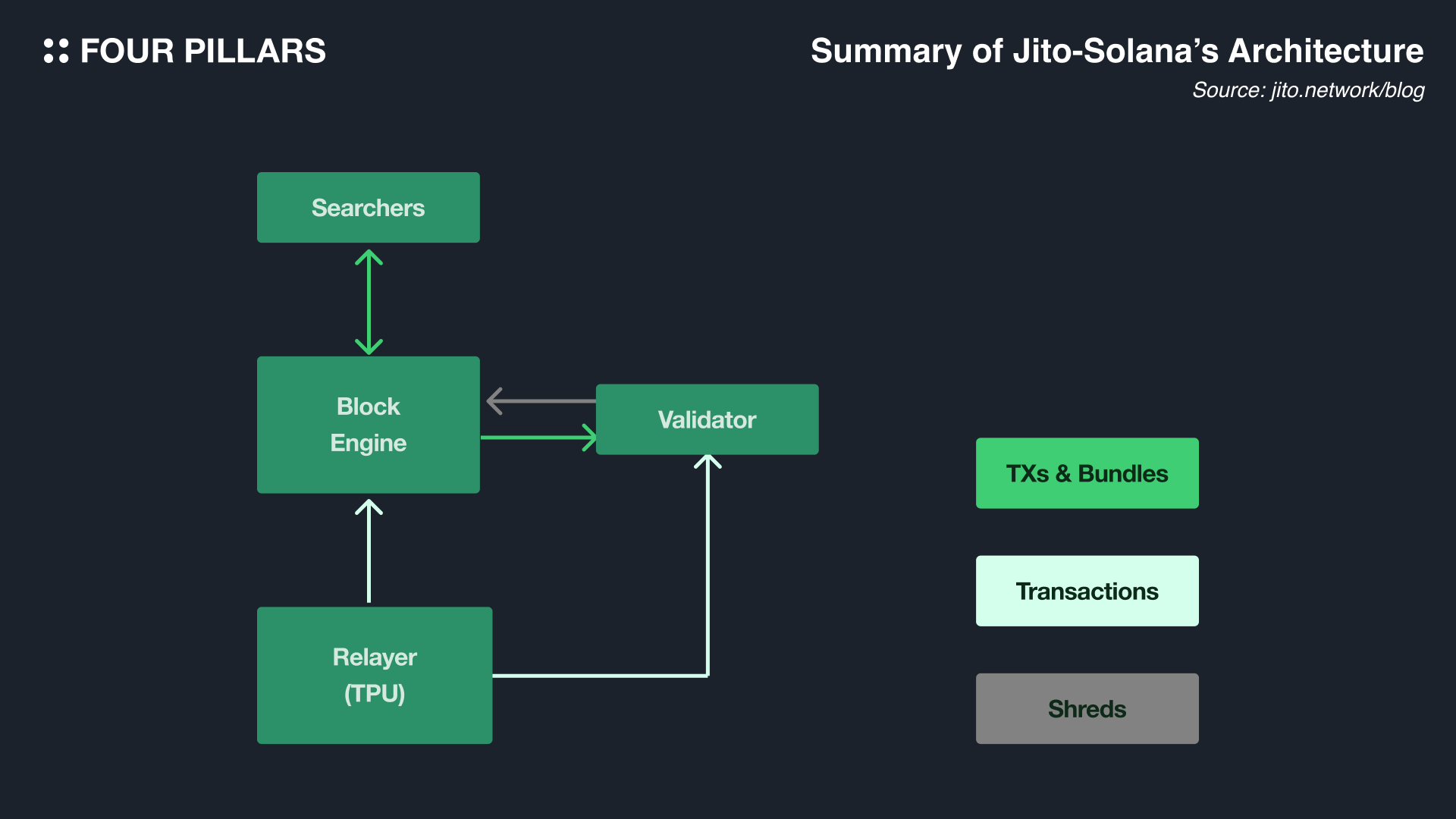
Source: jito.network/blog
Jito-Solana activates the MEV marketplace, akin to Flashbots' MEV-boost solution in Ethereum. However, due to Solana's unique design, lacking a mempool and processing transactions primarily in a first-come-first-serve manner with significantly faster block times compared to Ethereum, Jito-Solana operates differently.
Jito's MEV client introduces a virtual memory pool that conducts auctions every 200ms, streamlining the MEV extraction process. WIth Jito-Solana, searchers can examine transactions and simulate bundling through Block Engine, and then approach the leader node through a dedicated processing pipeline. This off-chain processing of transaction bundling and block auctions minimizes impact on network congestion.
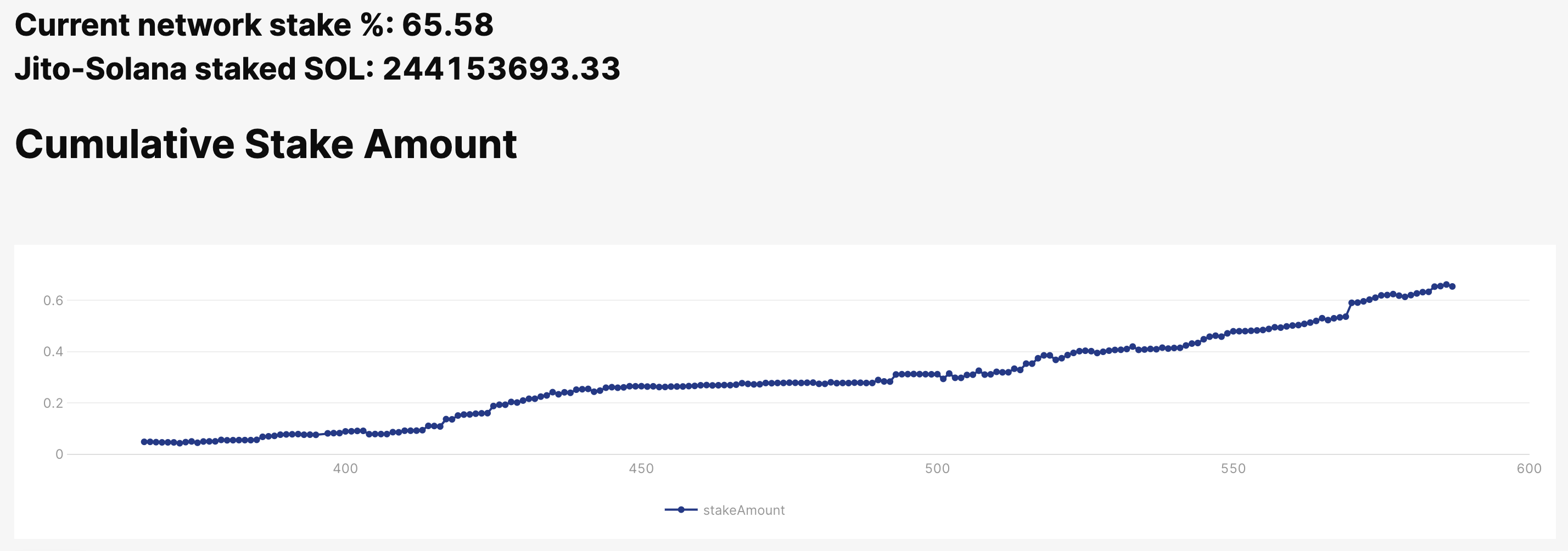
Source: jito.retool.com
Since its launch in August 2022, Jito-Solana has steadily grown in adoption, showing a 65% adoption rate as of this article.
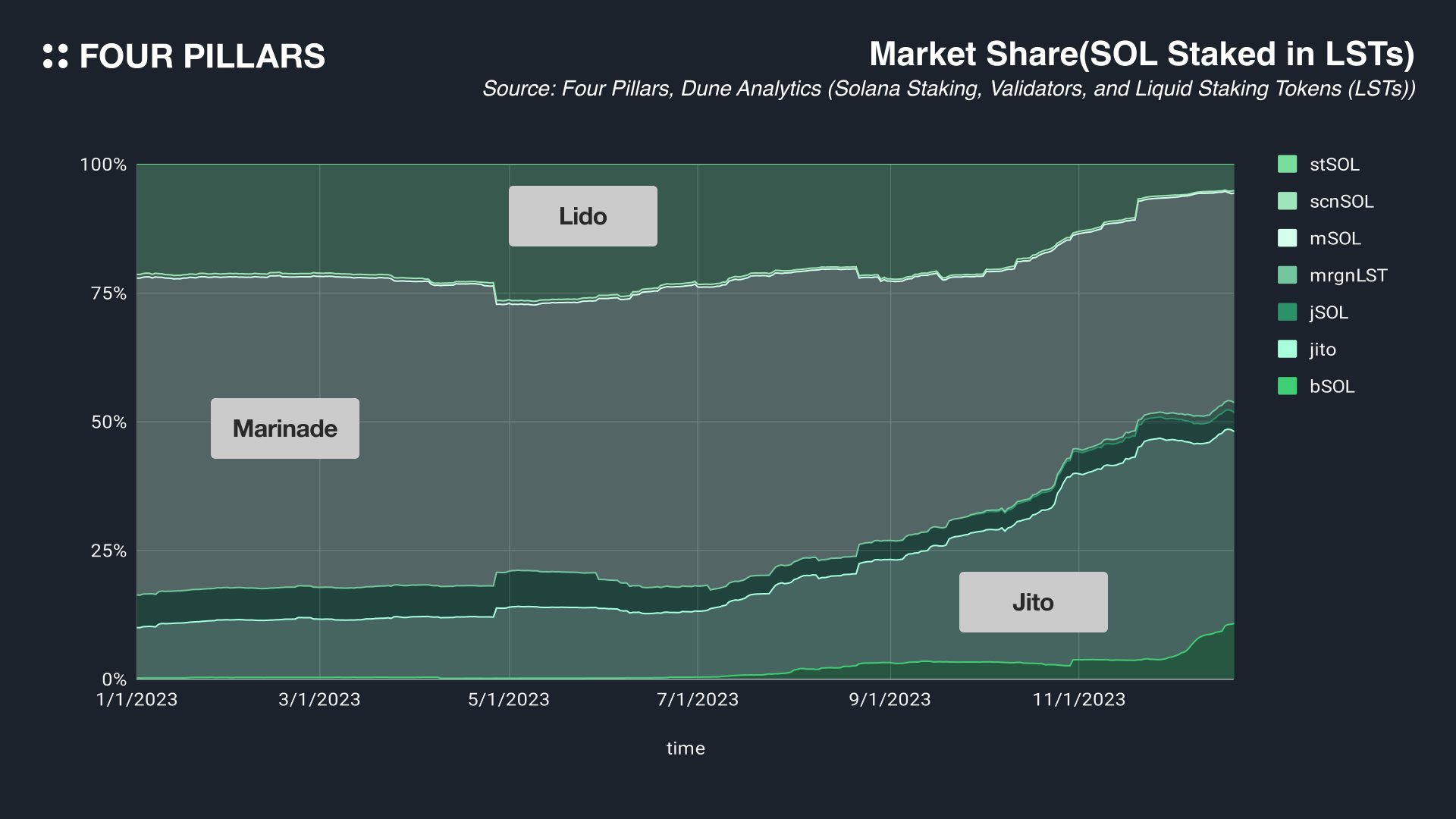
Additionally, Jito has introduced a liquid staking mechanism (i.e., JitoSOL) to its MEV solution, extending MEV earnings to its users and contributing to the expansion of the DeFi ecosystem. They aim to apply JitoSOL operations in a permissionless manner through StakeNet.
4.2.2 Firedancer
Firedancer, being developed by the Jump Crypto team, is a new validator client completely re-implementing Solana Labs' client in C and C++. It aims at enhancing performance through software optimization and increasing the diversity of validator clients within the ecosystem. Its demo version showcased at the Breakpoint conference in November 2022 demonstrated the ability to process up to 1.2 million TPS(600k after duplication).
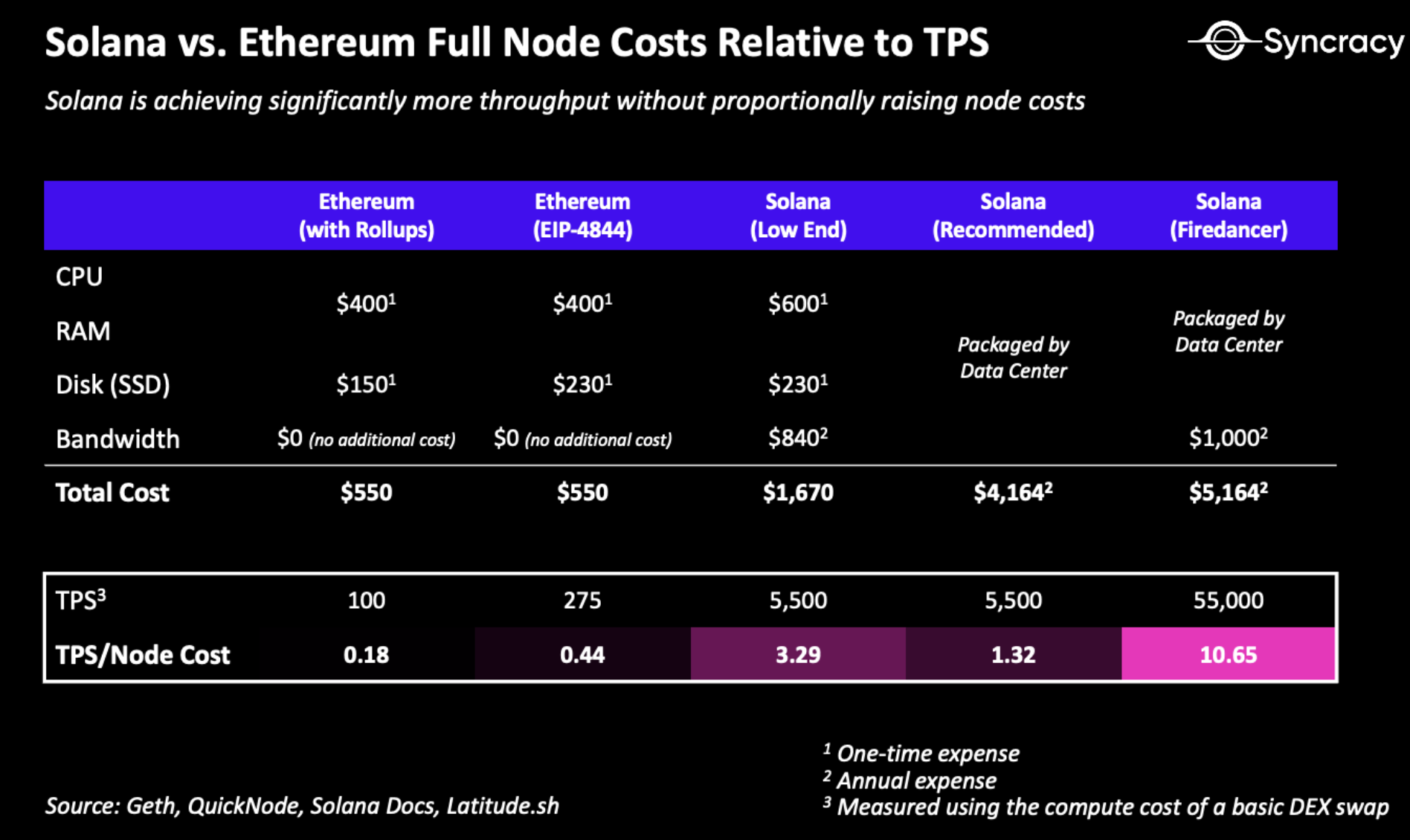
Source: Syncracy
According to Syncracy's 'Solana Thesis – The Fastest Horse Rises From the Ashes', using Firedancer could slightly increase node operation costs but achieve a competitive TPS/Node Cost ratio by reaching approximately 55,000 TPS*.
A significant difference between Firedancer and existing clients is its modular architecture, consisting of numerous individual processes known as Tiles, allowing for the optimization of each process. Currently, Firedancer is being tested on the testnet environment through a hybrid client named Frankendancer, applying the latest runtime environment and consensus module of the existing client to Firedancer's architecture.
*We have to wait and see when it goes live, but if Firedancer performs significantly better than existing clients, node operators' client choices will be driven to Firedancer, and client diversity may not be achieved in practice.
4.2.3 Tinydancer
The Solana network lacks a light client feature that allows for state validation without running a full node, limiting its validation capabilities. To address this, Tinydancer, a light client under development, enables transaction verification at a low cost without downloading the entire block or executing transactions. It alerts the full node it depends on when suspicious transactions are detected.
Introducing light clients like Tinydancer into the Solana network, which requires high hardware specifications for node operation, is a crucial milestone for enhancing accessibility and the potential for validation. While the design of Tinydancer has not been finalized, observing whether Solana can provide substantial validation capabilities to a broader user base and achieve ‘decentralization through affordable verification’ remains to be seen.
Having a variety of clients is crucial because any inherent code flaws in the small number of client softwares could potentially cause catastrophic damage to the entire network. Watching how the current and upcoming clients evolve to optimize Solana network performance will be interesting, but the fact that these initiatives are underway is undoubtedly a positive development for the Solana Network.
Solana not only provides developers with a well-established technical stack, as introduced earlier, but also offers a rich toolkit and set of standards to support the efficient and effective development of diverse applications on the Solana platform. Broadly speaking, the prominent frameworks include:
The Solana Program Library is a collection of on-chain programs developed by the Solana team and community, serving as a standard library for Solana developers. It includes a pre-built set of programs and utilities, such as token creation and management (SPL Token program), token swaps, lending protocols, etc., facilitating the development of decentralized applications on the Solana blockchain.
The Anchor Framework is particularly popular among developers new to Solana or those looking to rapidly prototype and deploy applications. It offers Rust-based DSL, IDL, a testing framework, and a suite of tools for security.
GameShift is designed to streamline the process of creating blockchain-based games, supporting various features like constructing in-game NFT marketplace.
UI frameworks like Scaffold and Wallet-Adapter allow developers to easily build front-end webpages and integrate with wallets within the Solana ecosystem.
Additionally, there are loggers like Geyser, Sologger, and IronForge, a more enriched program testing environment provided by BankRun.js, and a web-based IDE called Solana Playground, among many other documents, frameworks, and toolings available.
Given the vast scope of the frameworks introduced, some standards and sub-frameworks within the entire category that make Solana's unique features stand out or are worth looking forward to are highlighted below.
4.3.1 Token 2022 (Token Extension)
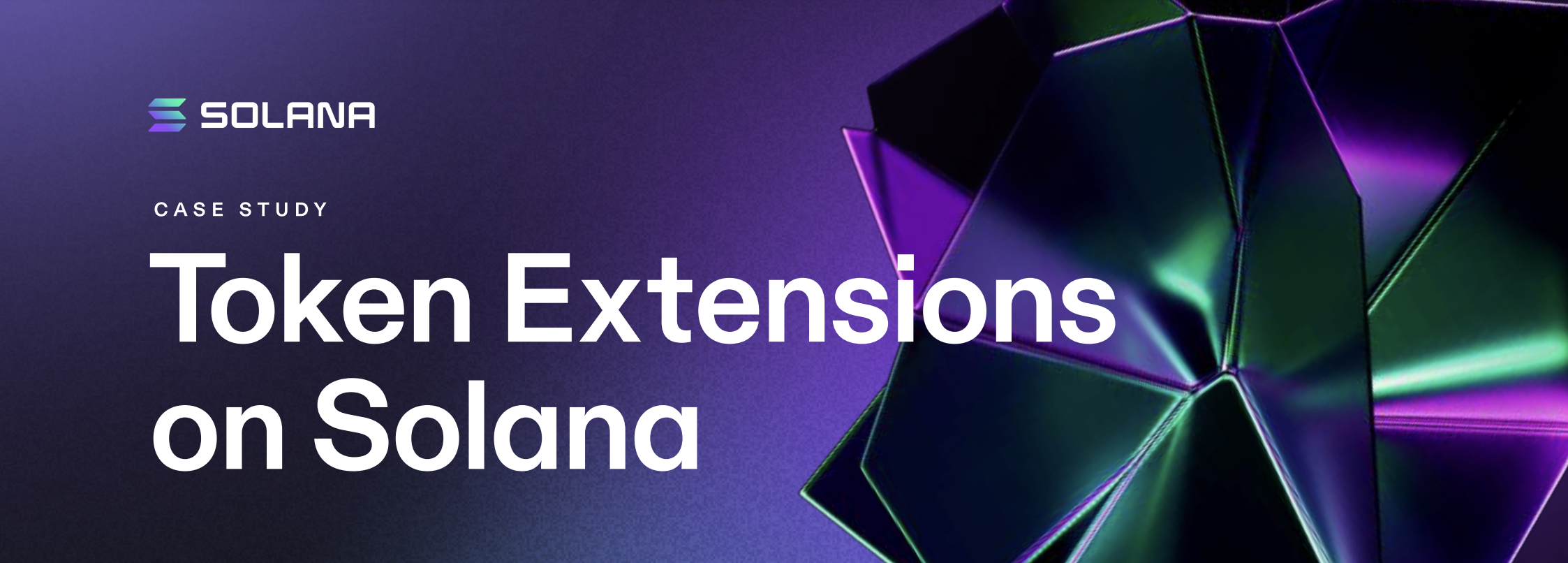
Source: Token Extension Paper by Solana Labs
While Ethereum freely proposes various token standards, Solana has operated with a single SPL token standard, limiting the flexibility of standard extensions compared to Ethereum. With the blockchain's evolution and the rapid increase in demand for complex token functionalities (e.g., RWA), Solana Labs developed a new token standard, 'Token 2022 (Extension),' embedded in the protocol layer to address such inefficiencies.
This new standard adds configurable features to the existing SPL token to support various use cases without additional libraries. Token Extension types include 1) Mint Extension and 2) Address Extension.
The former extends the token's functionalities, including Transfer Hook for conditional execution of programs upon token transfers, Transfer Fee for directing fees to specified accounts, enriched Metadata, and features like Non-Transferable Token and Confidential Transfer. The latter includes features related to account management, such as Immutable Owner to prevent reassignment of account ownership, and Default Account State for setting account states that require specific interactions with projects to use the account and assets.
Detailed functionalities and use cases are described in the paper by Solana Labs. However, from a functional perspective, the standards implementable with Token Extension have already been discussed or adopted within Ethereum's ERC standard space, still not encompassing Ethereum's standard spectrum. However, a critical difference is that, unlike Ethereum's application-level ERC standards, Token Extension is implemented at the protocol layer. This brings significant advantages, as developers can quickly configure programs without worrying about compatibility issues across different applications - we are already seeing how fragmented the utilization of Ethereum's ERC-4337 account abstraction standard deployed at the application level is).
As of writing, the mainnet deployment schedule for Token Extension is set for winter 2024, with updates available through this link.
4.3.2 xNFT (Executable NFT)
Anyone who has interacted with blockchain knows that UX still has a long way to go. The standard introduced here has the potential for widespread adoption and could significantly upgrade the UX.
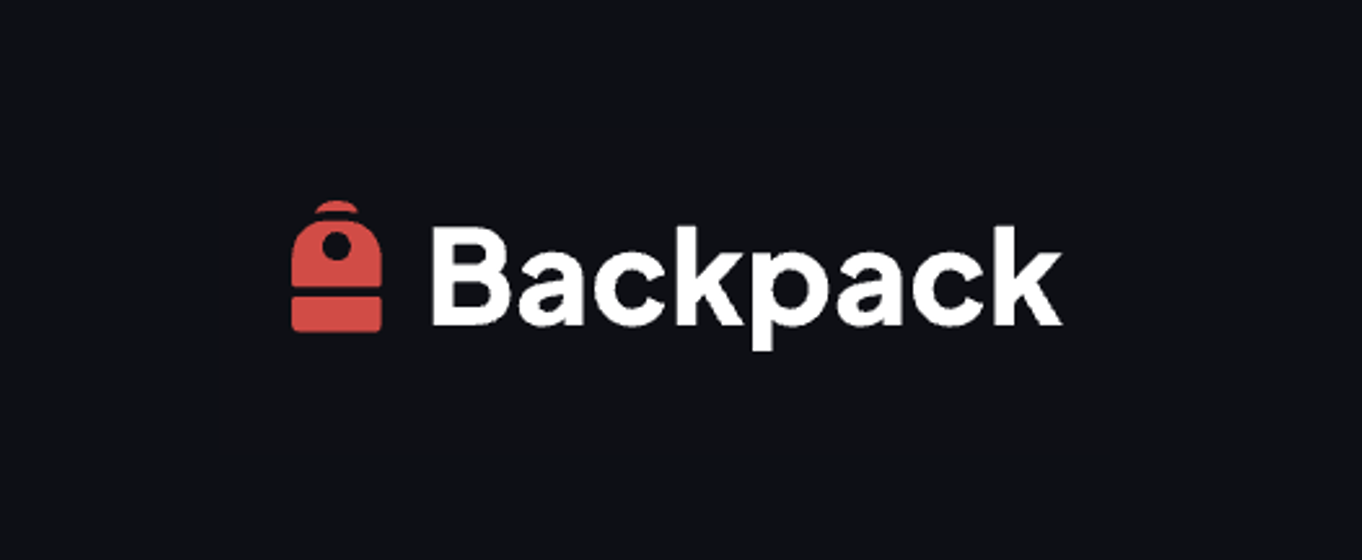
xNFT, developed by developers at Coral for the Solana blockchain, represents 'executable' assets or codes. Simply put, implementing code through xNFT plugins turns it into a functioning web3 application asset.
Coral has built 'Backpack' as an environment where xNFTs can operate, resembling a super app wallet integrating various web3 applications (i.e., xNFTs) without the need for separate connections or movements.
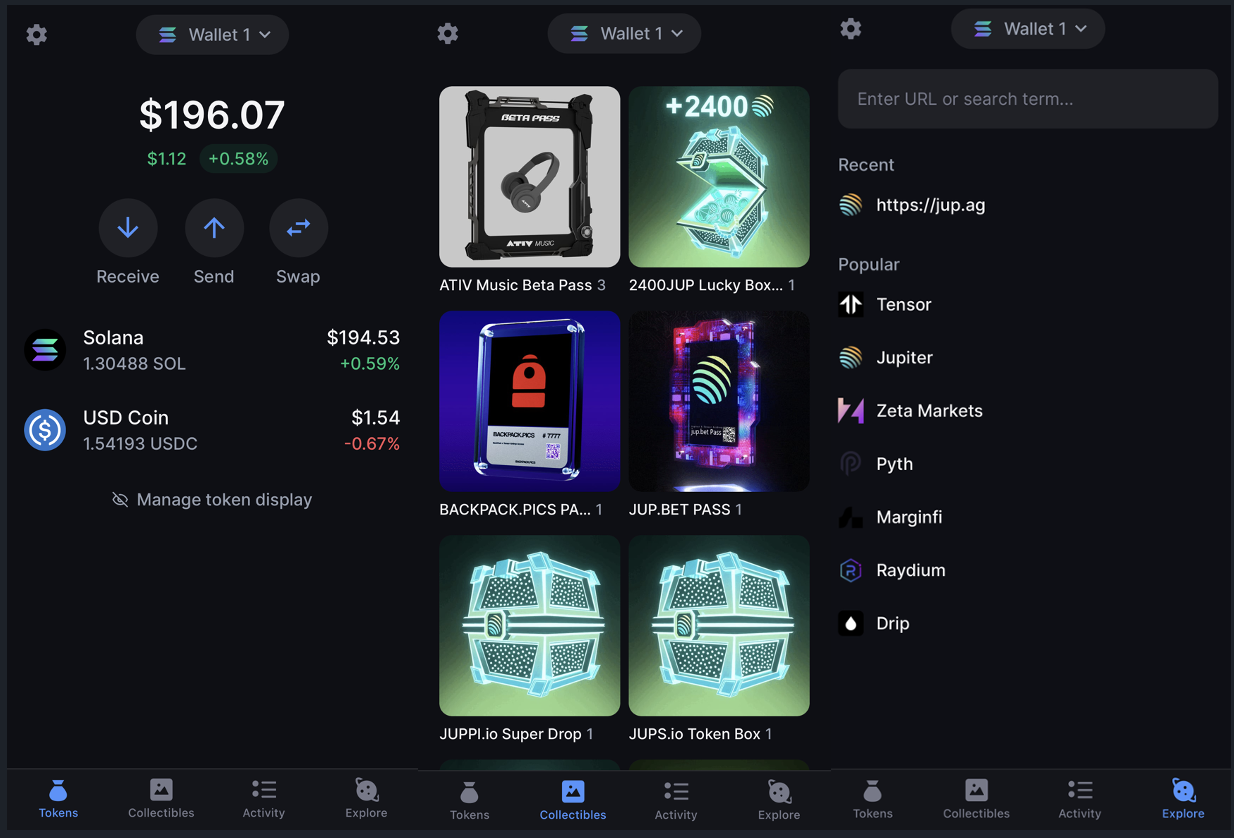
Source: Backpack Application
Currently, about 90 applications have been released in xNFT format across gaming, NFT, DeFi, and more. Backpack and xNFT standards, provided as fully open-source based on React, could bring significant UX innovations to the decentralized application market if more xNFTs are onboarded and support for various blockchains is extended. Recently, Backpack integrated Backpack Exchange into its interface in a preseason beta, recording $300 million in trading volume on its first day, proving its potential.
4.3.3 State Compression
Storing data on the Solana network requires opening a token account and paying rent. While the cost for posting small amounts of data may be negligible, it becomes a concern for large data volumes. State Compression, devised by combining Solana Labs' account-compression and Metaplex's Bubblegum program, addresses these issues.
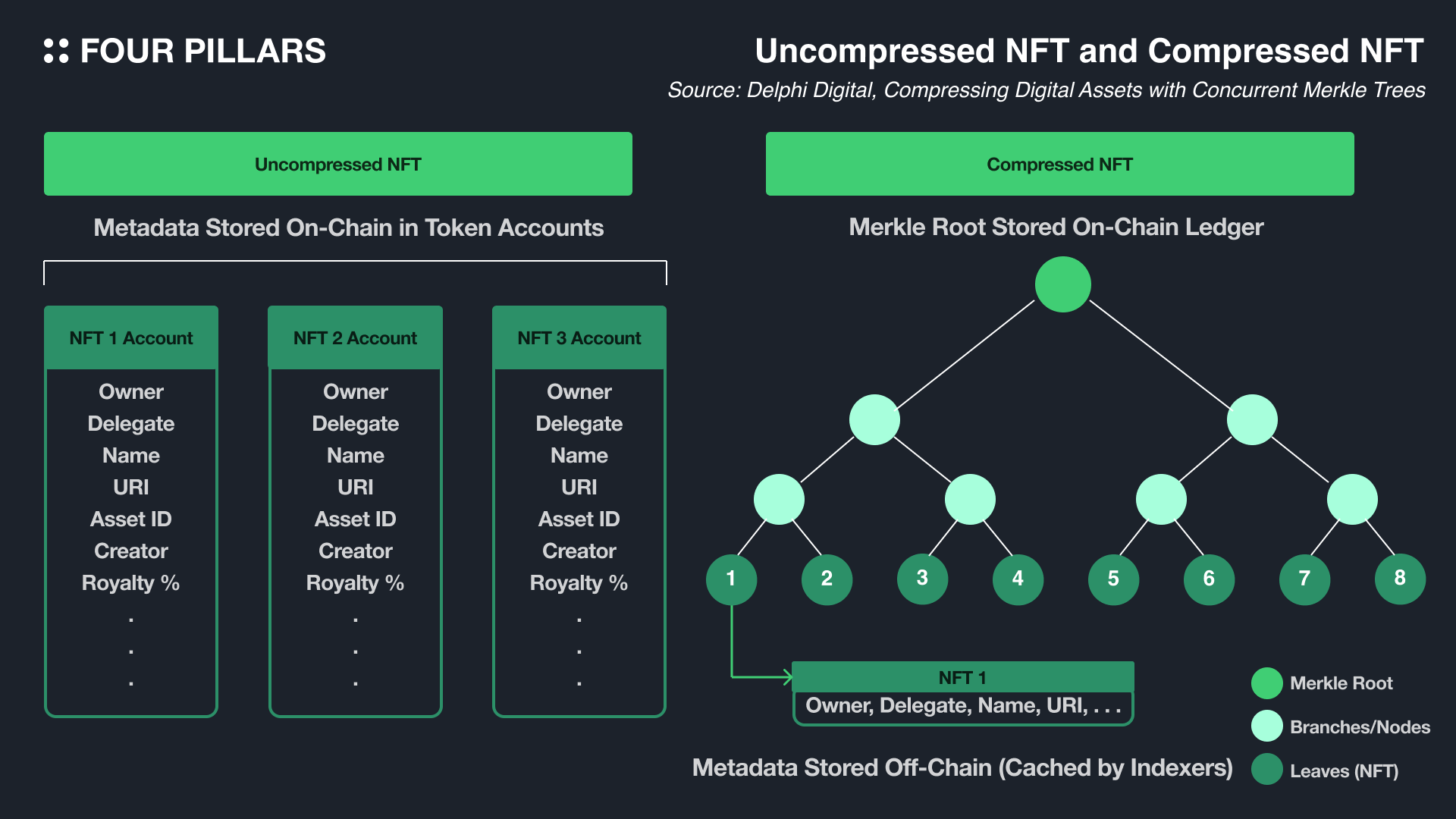
State Compression uses a Merkle tree structure to hash each asset's metadata at the leaf nodes, applying it to the structure and storing the resulting root hash at the top in the ledger. This method allows for secure data storage using cheaper blockchain ledger space instead of expensive account space, especially suitable for NFTs due to the bulk information management nature.
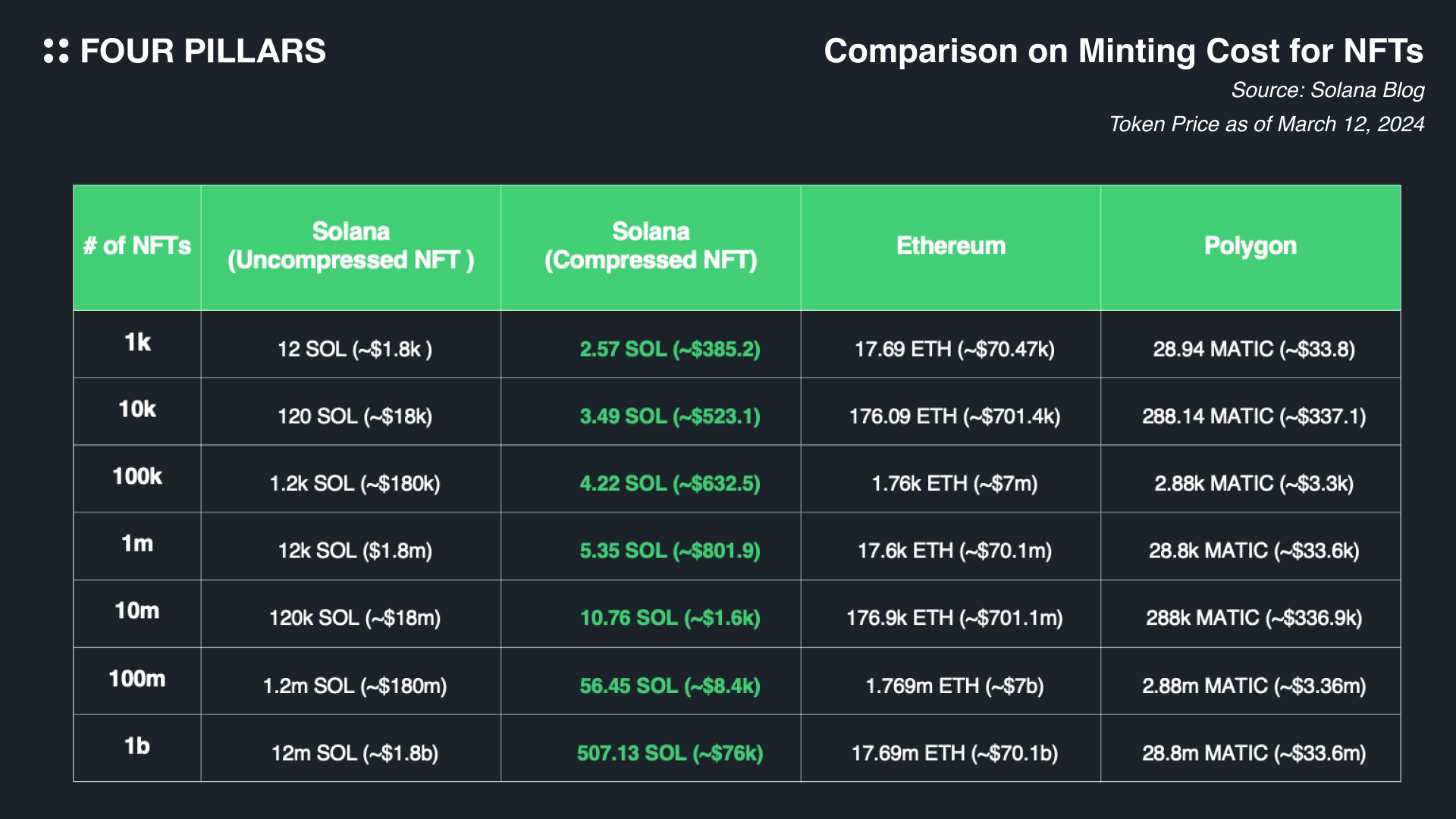
Therefore, compressed NFTs (i.e., cNFTs) follow the same metadata schema as uncompressed NFTs but are not inherently SPL tokens themselves; they only contain identifiers for potential decompression. The decompression process, turning cNFT into a standard Solana NFT, is unidirectional and enabled through Metaplex's Bubblegum Program.
However, since cNFT data is stored off-chain, a separate program defining interaction methods is needed, and this process relies on RPC providers, potentially incurring additional costs. Modifying cNFTs also involves complex and costly processes, like proving authorization to change off-chain data through encryption.
4.3.4 Solana Pay
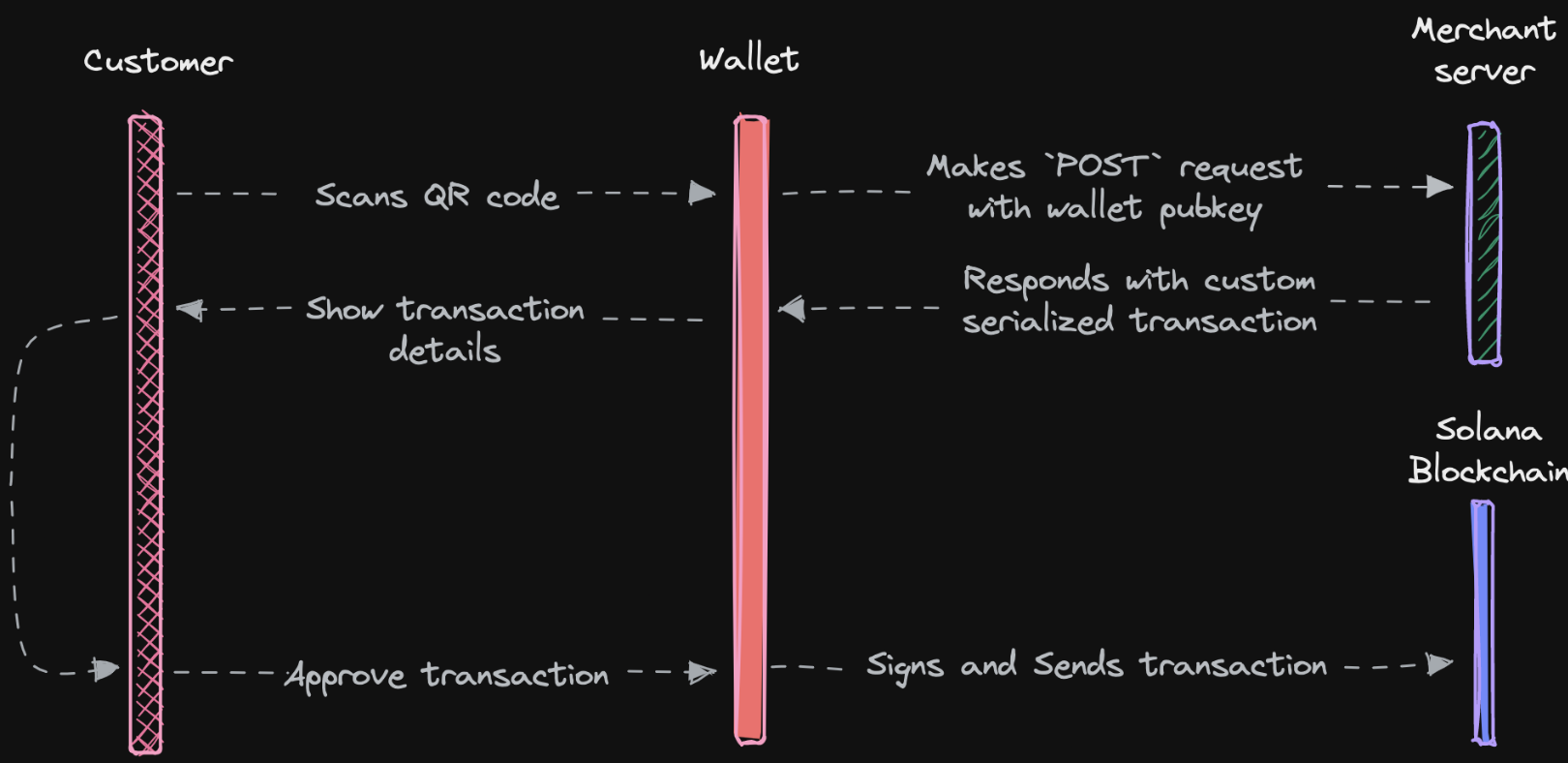
Source: Solana Pay Docs
Solana Pay, an open-source JavaScript library, simplifies cryptocurrency payments on the Solana blockchain. It uses a token transfer URL scheme to enable businesses or developers to accept payments in SOL or SPL tokens directly without intermediaries. Integration options like payment links, ‘Pay Now’ buttons, or QR codes are provided.
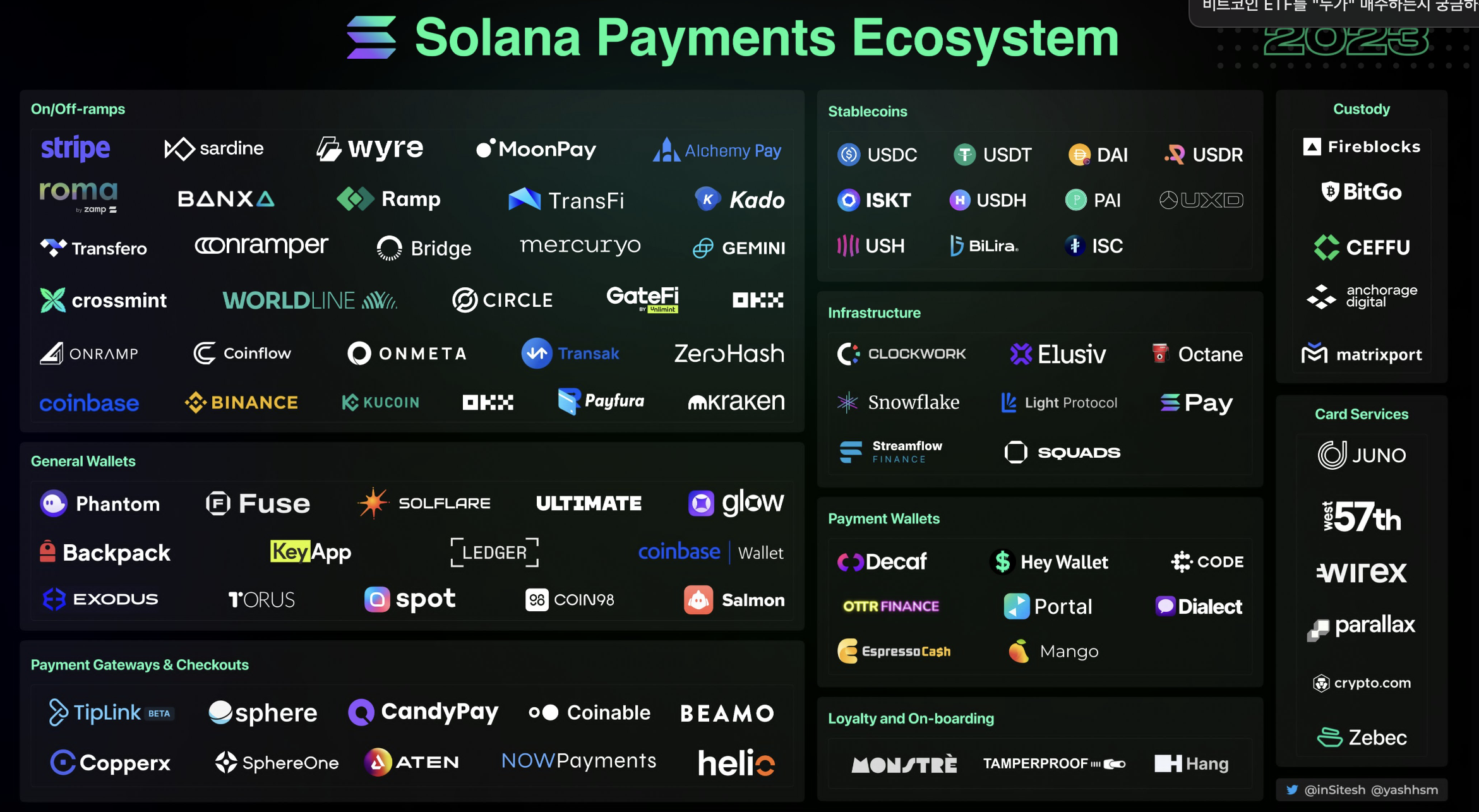
Source: Yash Agarwal
As mentioned before, Solana Pay's plugin has been integrated with Shopify, Citcon, Checkout.com, and over 100 companies/projects as well.
4.3.5 Solana Mobile Stack
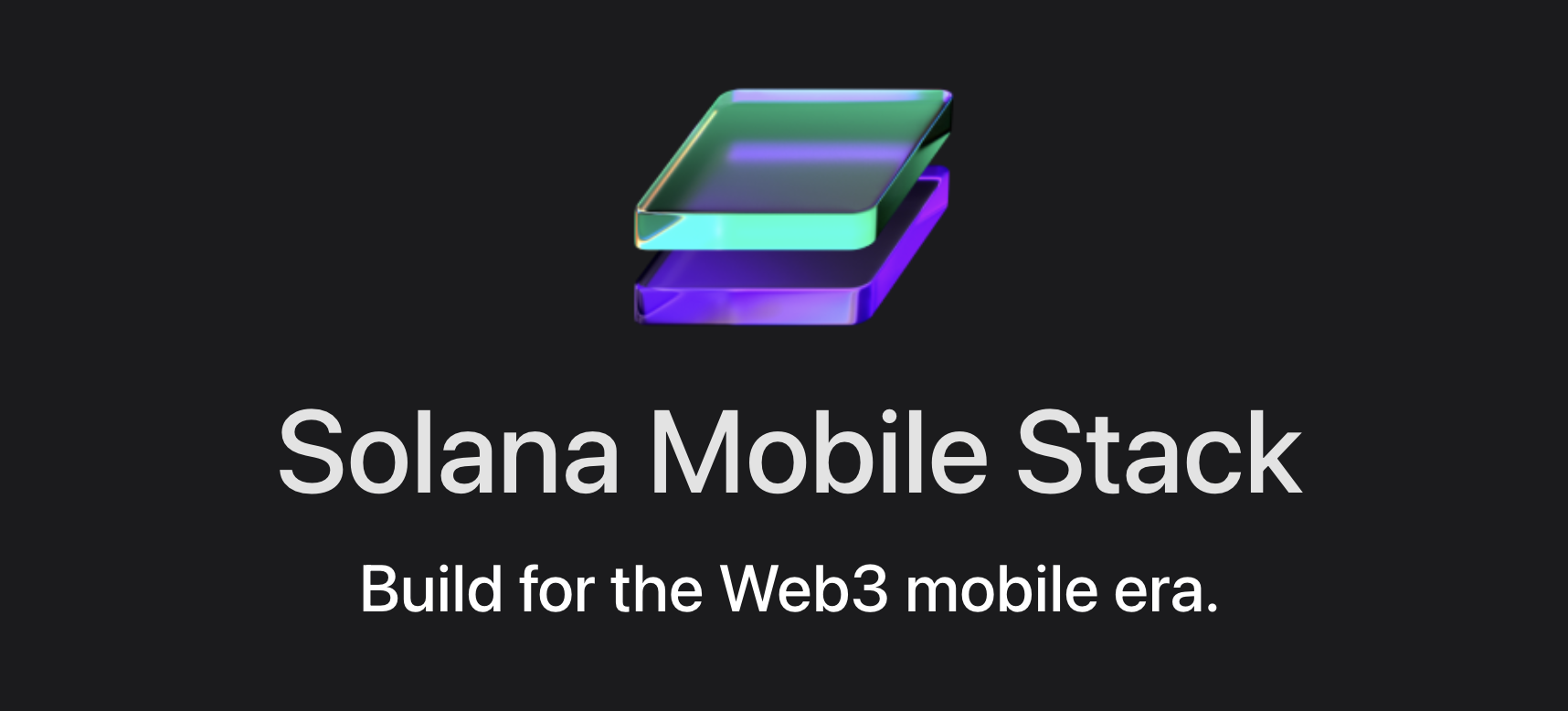
Source: SMS Docs
The Solana Mobile Stack (SMS) is an open-source SDK offering tools for developing applications on Saga series mobile devices by the Solana Foundation. SMS consists of the following main components.
Solana dApp Store - A dApp store specialized in the distribution of decentralized applications. It enables users to easily find, install, and use applications, with the ultimate goal of having the store's content primarily managed by the community.
Mobile Wallet Adapter - A standardized interface that facilitates smooth communication between applications and Solana wallets in a mobile environment. By integrating this adapter once, developers can easily connect to a variety of compatible mobile wallets. Currently, it supports Android and Mobile Web - Chrome (Android) only.
Seed Vault - Designed for use with the 'Wallet' application, this stack ensures the safekeeping of users' private keys and other important information. It allows all applications downloaded on the mobile device to utilize the same seed.
Solana Pay for Android - A payment system using the Solana blockchain, enabling users to easily make payments with Solana-related cryptocurrencies (i.e., SOL, SPL) in a mobile environment. Currently, only the Android SDK is available, and it supports Solana Pay requests to be executed through QR codes, NFC taps, messages, and web browser interactions to capture the Solana Pay URL.
Beyond these stacks, the SMS Docs provide SDKs for a variety of languages/development frameworks including React Native, Kotlin, Flutter, Unity, Unreal Engine, and Solana KMP. Solana aims to popularize blockchain usage in mobile environments and promote retail finance by providing users with integrated experiences of DePIN services, DeFi applications, and Backpack, among others, through the Saga series powered by SMS.
There's a close relationship between the development of internet speed and applications - in the early days of the internet, limited bandwidth and low transmission speeds made web page loading times long, reducing users' accessibility to multimedia content. This environment was conducive to developing simple web applications focused on exchanging text-based information.
However, the introduction of broadband internet and the advancement of data network technology have dramatically improved internet speeds, leading to increased complexity and functionality of applications. This has enabled the use of various high-bandwidth applications such as video streaming like Netflix, online gaming, large file sharing, real-time communication, and collaboration tools. In essence, the advancement of internet speed fundamentally changed the way digital content is consumed, stimulating the development of new applications and services.
We seem to experience this atmosphere once again through Solana - by leveraging its consumer/developer-friendly advantages while gradually improving its decentralization, Solana has created an ecosystem with over 700 decentralized applications just about 4 years after generating its Genesis Block.
However, this is just the beginning. Solana's vision exists far beyond, with the construction of an infrastructure capable of creating unprecedented new values, from efforts to optimize software for hardware, the introduction of various clients, to innovations in UX expected from xNFT & Backpack and the Solana Mobile Stack for integrated experience. And this will explosively give birth to more innovative applications.
While detailed introductions to each project will be covered in separate articles, in the following sections of this article, we will briefly introduce some of the most anticipated projects based on Solana’s current progress.
Neon EVM allows Ethereum Virtual Machine (EVM) to run on the Solana blockchain. The goal of this project is to enable Ethereum-based applications and smart contracts to leverage the fast processing speed, low transaction cost, and parallel processing benefits of the Solana network. Ethereum developers can easily migrate their existing Ethereum applications to the Solana network through Neon EVM. Neon EVM allows access to data stored in Solana accounts, and all Ethereum accounts within Neon EVM are stored in corresponding Solana accounts.
Eclipse is an Ethereum Layer 2 based on SVM using Ethereum as a settlement layer, Celestia as a data availability, and RISC Zero's zero-knowledge proofs to secure transaction capacity.
Nitro serves as a bridge between Solana and Cosmos, aiming to integrate the Cosmos and IBC ecosystems with Solana's runtime environment. Nitro is developing service using Sei Network as the settlement and consensus layer, and Nitro as the execution layer, allowing Solana developers to access liquidity of IBC assets and deploy assets or programs to the Cosmos chain through Nitro.
Created through a partnership between Solana and Certus One, Wormhole is a bridge protocol that enables the transfer of messages and assets across multiple blockchains, including Solana. Wormhole's wrapped assets are among the most liquid on Solana, with the main goal of overcoming the liquidity fragmentation problem in the blockchain ecosystem and building an integrated environment where assets and information can freely move between different networks.
Started within the Solana ecosystem in July 2021 as Solbridge, Allbridge rebranded to expand beyond Solana to various chains. Along with Wormhole, Allbridge is one of the most active protocols deeply integrated into the Solana ecosystem, adding various features such as Circle’s CCTP integration, support for several messaging protocols, and more.
LI.FI (Linked Finance) is a ‘multichain liquidity aggregation protocol’ that integrates various bridge solutions and DEX aggregators across networks, enabling swaps between any networks. LI.FI operates under the thesis that infrastructure fragmentation will persist, thus, underlying multicellular infrastructure is necessary for mass adoption.
Helius is a platform that provides APIs, RPC nodes, web-hooks, and developer tools to enable the development of stable blockchain applications within the Solana ecosystem.
Pyth Network is an oracle network providing real-time primary financial market data essential for DeFi services on the blockchain. Currently, Pyth Network collects data from over 90 First Party data providers and offers real-time price feeds for cryptocurrencies, stocks, ETFs, commodities.
(Refer to 4.3.2 xNFT (Executable NFT))
Solflare and Phantom are the most widely used wallets in the Solana ecosystem. Phantom wallet is particularly known for its user-friendly interface and NFT management features in a mobile environment, while Solflare wallet is renowned for its sleek interface in the web environment and focus on security aspects.
Hey Wallet is a Solana-based cryptocurrency wallet designed to help Solana ecosystem users manage their digital assets simply and intuitively. Users on Hey Wallet can send and receive SOL and SPL tokens via Twitter's X posts.
Squads is a multi-signature solution that enables companies to manage and operate their assets more securely. Through Squads, companies can perform a variety of tasks such as financial management, program upgrades, and token distribution in a safer environment requiring multiple team members' approval. Moreover, Squads offers a wide range of functions to enhance security and efficient asset management for Solana-based projects.
Helium, utilizing Solana's performance and State Compression features for easier device identification and market potential expansion, migrated to Solana to become a 5G wireless network DePIN. Users of Helium's IoT device hotspots pay network costs in HNT, which is distributed to the hotspot operators. The Helium network, compatible with a variety of devices, recently launched a $20 per month phone plan offering unlimited data, calls, and texts across the US.
Hivemapper is a global mapping network that collects real-time, high-resolution road images using vehicle dashcams, rewarding contributors with $HONEY tokens. The network has already mapped over 125 million kilometers of roads, and users can track their location in real-time with the Scout toolkit. The price for Hivemapper's dashcam ranges between $400 and $600.
Render Network is a distributed GPU rendering network based on the Solana blockchain, where users can offer or utilize computing power for complex 3D rendering tasks, using Render tokens. Render Network employs the BME (Burn Mint Equilibrium) model to balance the supply and demand of tokens, ensuring consistent pricing for services.
Similar to Render Network, io.net is a distributed GPU computing network based on Solana. Unlike Render Network, io.net focuses more on inference, parallel learning, hyper-parameter tuning, and reinforcement learning. The two projects partnered last November to expand the pie in the GPU Supplier market.
IoTeX is a modular Web3 infrastructure platform connecting smart devices and real-world data to the blockchain. Through protocols like W3bstream, IoTeX aims to solve the inaccuracies in data that could arise from using oracles, providing developers with a reliable infrastructure to build applications on real-world data. IoTeX has integrated with Solana, enabling Solana-based projects like Helium, Render, and Hivemapper to utilize IoTeX's platform to validate/use real-world data, activating rewards for contributors and users.
Teleport's Trip Protocol is a decentralized ride-sharing service built on the Solana network, designed to solve the centralization issues of existing ride-sharing companies. Through this protocol, drivers are guaranteed high earnings, and riders can enjoy the service at a lower cost.
Marinade Finance is a Liquid Staking Platform where users delegate their SOL tokens to Marinade to automatically earn staking rewards through various staking strategies and issue shadow tokens (i.e., mSOL) that can be used across various DeFi protocols. Marinade Finance has been at the forefront of the Liquid Staking Platform within the Solana ecosystem, introducing various incentive programs and more to enhance its offerings.
As previously mentioned, Jito operates the Jito-Solana client, maximizing MEV profits and sharing the revenue through a Liquid Staking Token (i.e., JitoSOL), rapidly increasing its market share in the Solana ecosystem's Liquid Staking Market. Like Lido's aim to operate their protocol in a permissionless manner, Jito also intends to apply a permissionless operation model to the JitoSOL Pool through StakeNet.
Sanctum is a solution that allows all Liquid Staking Tokens (LST) projects within the Solana ecosystem to share liquidity with each other, allowing for seamless interactions between each LST (e.g., zero slippage). Users can also earn revenue by supplying liquidity of a specific LST to the Sanctum Infinity pool.
Drift Protocol is a decentralized trading platform on Solana, focusing on improving order processing speed and market efficiency with its V2 upgrade. Users can engage in spot trading, perpetual trading, borrowing and lending, and passive liquidity provisioning in a market with real-time price updates.
Developed by the Ellipsis team, Phoenix is a new order book-based DEX aiming to provide an entirely on-chain, instant settlement trading experience. It is in a competitive relationship with OpenBook, a community fork of Serum V3, as they offer similar services. OpenBook places a bit more emphasis on community governance and control.
Jupiter is Solana's premier Dex Aggregator, providing the best routes for cheap trades of specific token pairs. With a large user base gathered through various airdrop strategies, Jupiter also offers limit orders, perpetual trades, DCA (Dollar-Cost Averaging), and bridging functionalities. Also, a launchpad is expected to be released in the near future.
Zeta Markets is a decentralized derivatives trading protocol built on the Solana blockchain, offering under-collateralized options and futures trading. Traders can buy and sell options and futures through an order book mechanism.
The marginfi protocol is a decentralized lending protocol on the Solana network. Its product suite includes mrgnlend, an over-collateralized lending/borrowing protocol. Beyond typical lending activities, marginfi protocol aims to enable users to engage in integrated financial activities with various DeFi protocols as a ‘Composable DeFi-Native Protocol’.
Kamino is a DeFi platform that combines various financial activities into one, where users can strategize to maximize earnings through lending/borrowing, liquidity provisioning, leveraging provided liquidity, and portfolio management. Along with marginfi, Kamino records the highest TVL among Solana's lending-supporting protocols.
Parcl is a platform that allows users to invest in the real estate market in a fractional ownership manner, based on a data feed tracking square foot prices across the US.
Magic Eden is the leading NFT marketplace on Solana, supporting a multi-chain environment including Ethereum, Polygon, and Bitcoin Ordinals, and offers launchpads for each project or BTC Inscriptions.
Tensor is a platform tailored for professional NFT traders on Solana, integrating AMM and marketplace functionalities for the first time. Users can access real-time data, candlestick-priced AMMs for NFTs, and employ various trading strategies, including mass acquisition, bidding, listing/delisting of NFTs. Alongside these features, Tensor conducts various reward programs for retail users, competing with Magic Eden for the top NFT marketplace position.
Metaplex offers a variety of tools to facilitate the creation, sale, and management process of digital assets in the Solana ecosystem, including ownership representation, permission management, the creation and distribution of compressed NFTs, etc.
DRiP is an NFT drop platform for creators, supporting new artists to join Solana easily and affordably. New artists seeking to build a fan base can issue their works as cNFTs and offer free NFT art mints through DRiP. Users can follow their favorite artists, send thank-you notes, or donate through Droplets 2.0.
Sphere is a project that won the Solana Summer Camp Hackathon in December, experimenting with various payment functionalities including on/off-ramp, on-chain subscriptions, invoices, and payment links.
The Code SDK is an open payment protocol and app that allows developers to easily collect micro-payments from users worldwide. Anyone can offer a "Pay with Code" button experience in a web environment, where users are charged a 5-cent fee, and developers require a 1-cent fixed fee to cover blockchain transaction costs.
TipLink is a lightweight, non-custodial wallet that enables easy transfer of digital assets via a link or QR code. Users can instantly create a wallet by linking their Gmail account or Solana wallet to the received link or QR code, utilizing the assets through this link.
Solchat is a communication protocol based on Solana, allowing users to engage in text, voice, and video calls within the Web3 environment. All messages and group chats are stored on-chain, while voice and video calls are conducted P2P via WebRTC. Solchat is expected to be actively used in the upcoming Solana Saga mobile as well.
Dialect is a decentralized messaging protocol implemented on the Solana network, enabling applications to send or receive tokens directly through messages.
Mad Lads is an NFT collection created by Coral, a company that develops frameworks for Solana and designed things like xNFT and Backpack. This NFT collection was built on the xNFT standard and aims to explore the potential of NFTs as decentralized applications. The release of Mad Lads played a crucial role in injecting new energy into the Solana community, which was facing difficulties due to the collapse of FTX.
MonkeDAO is the first NFT DAO on Solana, evolving from a decentralized community that began around the Solana Monkey Business (an NFT collection) in 2021. This organization actively engages in various initiatives, including operating a Solana validator, running a staking pool (i.e., SOL), hosting online events, and investing in early-stage projects, all managed 100% by the community. Through these efforts, MonkeDAO has contributed significantly to the early success and sustainable growth of the Solana NFT market.
LamportDAO is a community-led initiative focused on developer support within the Solana ecosystem. As of writing this article, it has over 4,000 members, providing developer resources, technical development support, promoting Solana features, and hosting Solana-specific hackathons to energize the community and support the onboarding of new developers.
Superteam DAO plays a role in promoting the advantages and ecosystem of Solana primarily in emerging markets such as India, Southeast Asia, Eastern Europe, and Africa. Comprising members with diverse experiences and backgrounds, this DAO creates a community-centered environment where innovative projects can be supported, invested in, and developed with support from various projects and officials within the Solana ecosystem.
Solana University is an international student organization hosting various events and distributing educational materials to advance education about Solana and Web3.
Bonk is a meme coin on the Solana blockchain, inspired by the widespread trend of meme coins in the cryptocurrency space. However, Bonk has become a culture symbolizing the resilience of Solana.
$MOTHER is a meme coin and community co-founded by famous rapper Iggy Azalea. Initially, it started purely out of curiosity about crypto. However, the unique characteristics of the meme coin community combined with Iggy’s active engagement created a synergy. Now, $MOTHER aims to serve as a 'godmother' helping the public approach the crypto space in a more fun and familiar way. Through various initiatives, $MOTHER has rapidly expanded its influence and has become one of the fastest-growing communities.

Many people, including Solana's Co-Founder Raj Gokal, describe Solana as ‘the Apple of the crypto world’, emphasizing the harmony between software and hardware and focusing on performance and UX. This analogy might make Solana's vision more relatable to us. However, ironically, what makes Solana even more exciting is not its similarities to Apple but its differences - the approaches of Solana and Apple are completely opposite.
Apple fundamentally sells hardware, making software essentially a means to sell hardware. Even during the launch of the iPod, which marked a significant milestone in Apple's remarkable journey, Apple adopted an approach that combined software, iTunes, to showcase its hardware experience. However, Solana takes an opposite approach, aiming to integrate hardware to encapsulate a web3 experience where numerous fully composable applications are organically interconnected. Thus, compared to Apple's approach, Solana's method is considered more sophisticated and ambitious, seeking innovation not just through convenient UX but by offering new experiences through the software itself.
In the end, technology is worthless if not used. Think simply. One of the primary values we seek from blockchain is for it to function as an innovative internet infrastructure that can complement real-world systems in such ways.
While Bitcoin and Ethereum have presented an ideal vision for the future of blockchain, Solana is contemplating how to realistically apply this process and is the first to actively pioneer the practical use case areas. Perhaps we have been overly consumed by the blockchain trilemma defined by Vitalik, limiting our imagination to where each blockchain stands within that spectrum. Ultimately, the protocol that creates the most significant value will be the one that best understands the needs of users and developers to ship those experiences.
Thanks to Kate for designing the graphics for this article.
We produce in-depth blockchain research articles

Let’s learn about Sei DB, one of the most important features of Sei v2.

This covers the Injective Network, which has undergone consistent development and change in the market over the past four years.

Explore the origins of the Sui blockchain and its technologies in detail, and investigate how Sui differs from other blockchains

Explore the lessons learned from how dYdX has changed its product over the past 5 years, focusing on its history.